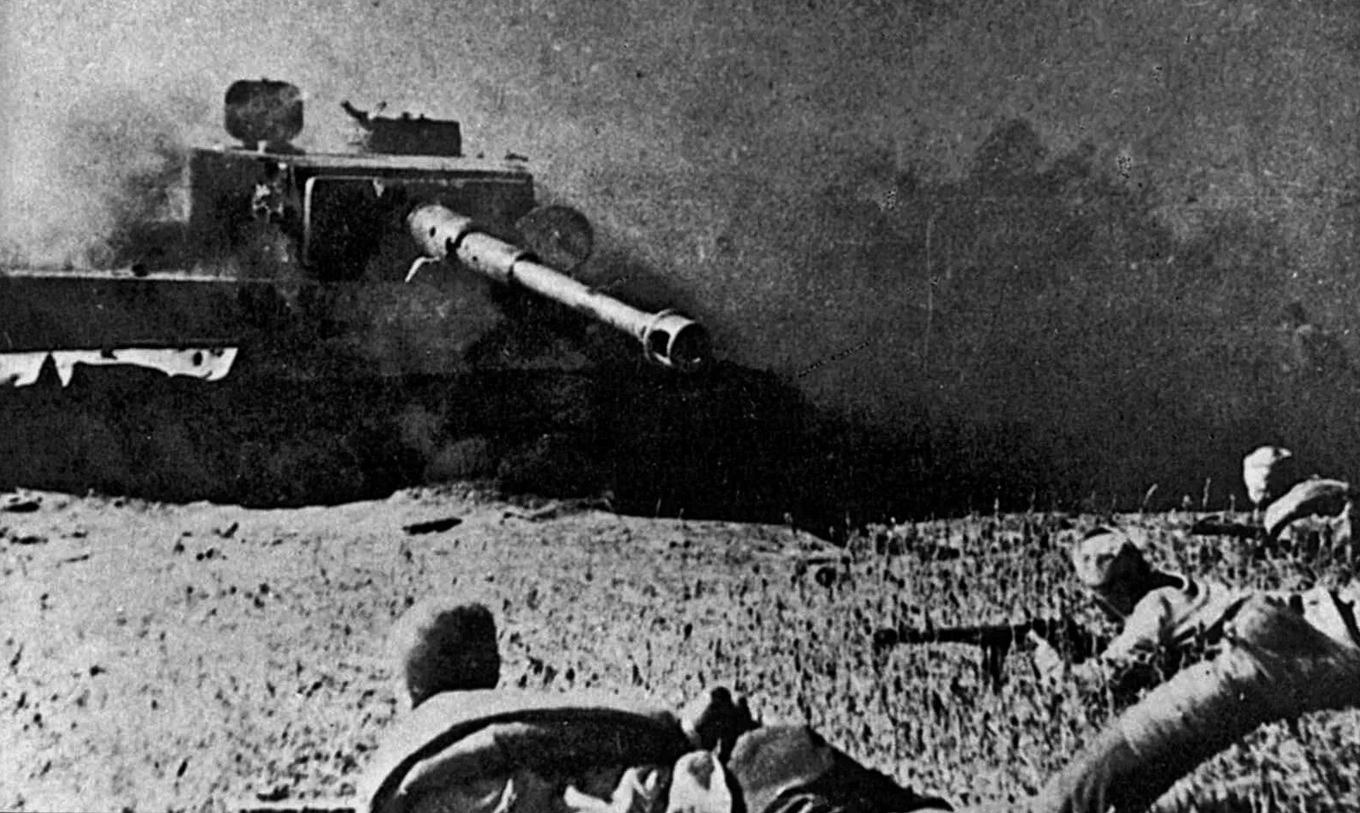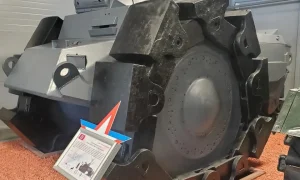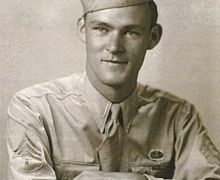The Battle of Kursk (July 5 – August 23, 1943 – a set of strategic defensive (July 5-23) and offensive (July 12 – August 23) operations of the Red Army in the Second World War in order to disrupt a major offensive forces of the Wehrmacht and defeat its strategic grouping. In terms of its scale, forces and means involved, tension, results and military-political consequences, it is one of the key battles of the Second World War and the Great Patriotic War. In historiography it is considered the largest (greatest) tank battle in history. The battle of Kursk involved about 2 million people, 6 thousand tanks, 4 thousand aircraft; the battle paved the way for the great Soviet offensives of 1944-45.
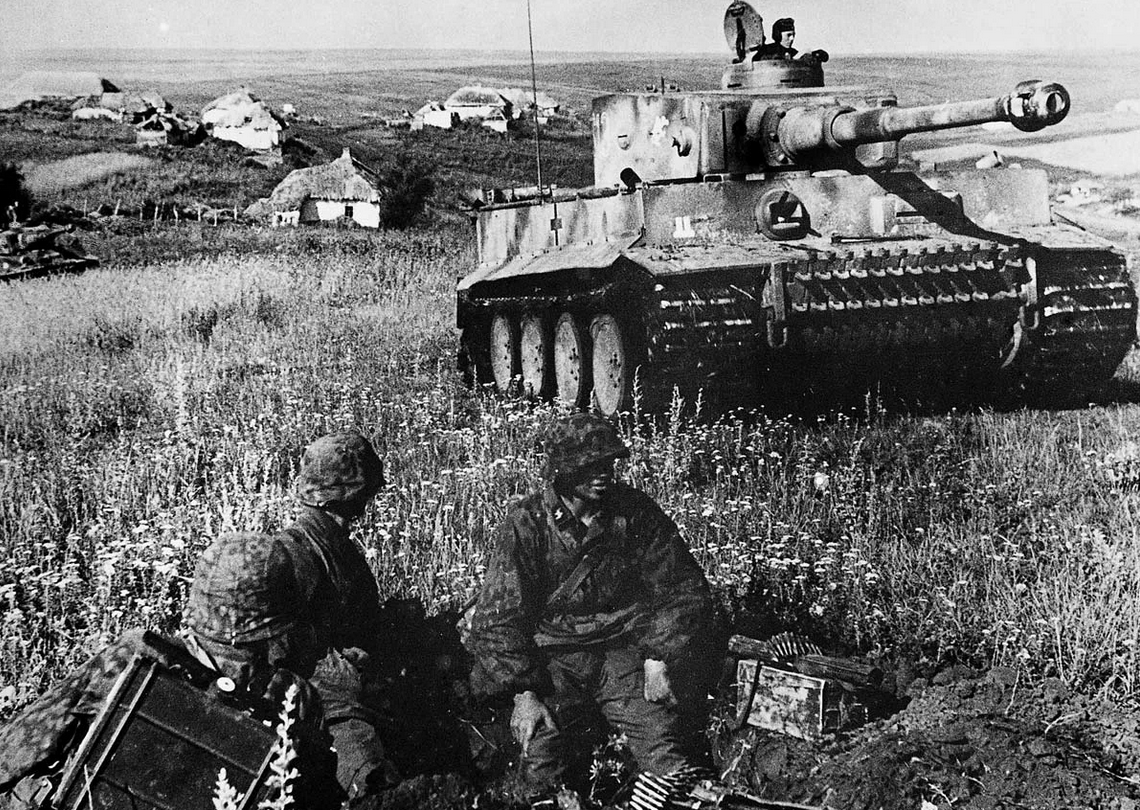
Kursk Battle Tiger Tank with Panzergrenadiers
The battle is the most important part of the strategic plan for the summer-autumn campaign of 1943, according to Soviet and Russian historiography, it includes: the Kursk strategic defensive operation (July 5-23), Oryol (July 12-August 18) and Belgorod-Kharkov (3-23 August) strategic offensive operations. The battle lasted 50 days. The German side called the offensive part of the battle Operation Citadel.
As a result of the offensive according to the Kutuzov plan, the Oryol grouping of German troops was defeated, and the Oryol strategic bridgehead occupied by it was liquidated. As a result of Operation Rumyantsev, the Belgorod-Kharkov group of Germans was defeated, and the corresponding bridgehead was also liquidated. The radical turning point in the course of the Great Patriotic War, begun near Stalingrad, was completed in the Battle of Kursk and the battle for the Dnieper, and in the ensuing Tehran Conference, on the initiative of F. Roosevelt, the plan he had personally drawn up “2 months ago to divide Germany into five states” was already discussed.
After the end of the battle, the strategic initiative finally passed to the side of the Red Army, which continued to liberate the country from the German invaders and carried out mainly offensive operations until the end of the war. The Wehrmacht during the retreat from the territory of the USSR carried out the tactics of “scorched earth”.
August 23, the day the Soviet troops defeated the German troops in the Battle of Kursk, is one of the days of Russia’s military glory. Belgorod, Kursk and Orel became the first Russian cities to be awarded the honorary title of “City of Military Glory”.
Tank Battle
Colonel General O. A. Losik, speaking of the combat experience of using tank armies, he cites the following figures:
“The history of wars… did not know another such tank battle as unfolded near Kursk. More than 6 thousand tanks and self-propelled guns took part in it from both sides. On our side, especially large tank forces participated in the counteroffensive. The fronts included five tank armies, 14 separate tank and mechanized corps, as well as a significant number of separate tank brigades and regiments, numbering about 5 thousand tanks and self-propelled artillery installations. This is 7 times more than in the counteroffensive near Moscow, and almost 5 times more than near Stalingrad.
The chief of staff of the 48th TC, General Friedrich Wilhelm von Mellenthin, notes that “the strike from the south was to be delivered by ten tank, one motorized grenadier and seven infantry divisions”; in the northern grouping “seven tank, two grenadier motorized and nine infantry divisions were to take part” and gives his assessment:
This operation was destined to become the greatest tank battle in the history of warfare.
Preparing for battle
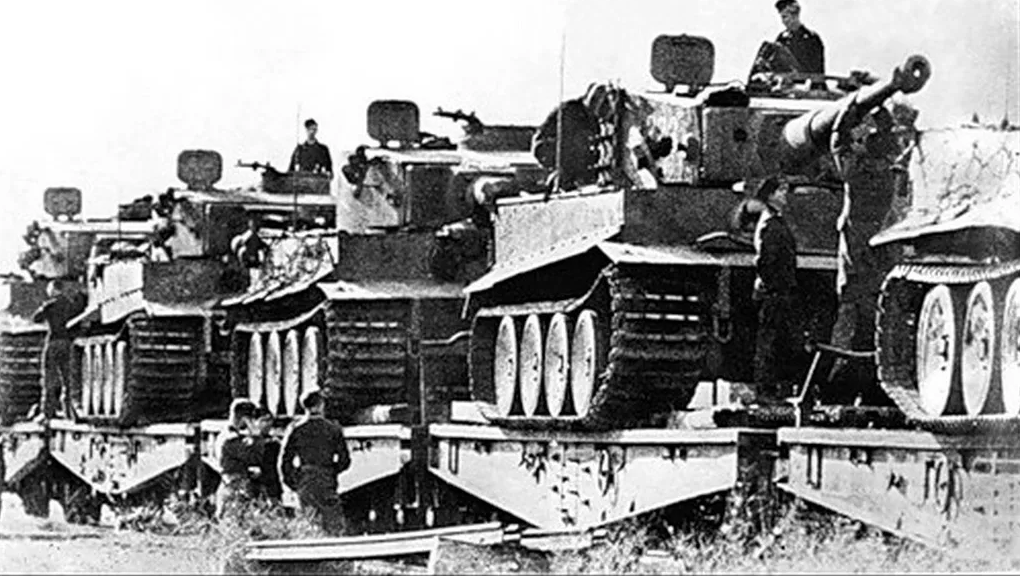
Tiger Tanks on Transport
During the winter (1943) offensive of the Red Army (Ostrogozh-Rossosh operation, Voronezh-Kastornenskaya operation (1943)) and the subsequent counteroffensive of the Wehrmacht (see Third battle for Kharkov), a ledge up to 150 km deep was formed in the center of the Soviet-German front and up to 200 km wide, turned to the west (the so-called “Kursk Bulge”). During April-June 1943, there was an operational pause at the front, during which the parties were preparing for the summer campaign.
Planning for the summer-autumn campaign of 1943
The operational and strategic significance of the Kursk ledge and the German bridgeheads located to the north (Orlovsky) and to the south (Belgorod-Kharkov) largely predetermined that it was here that the decisive events of the summer-autumn campaign of 1943 would unfold, for which both sides began to prepare already in early spring. A. M. Vasilevsky, who directly developed (as the head of the General Staff) the strategic plan for the summer of 1943, wrote:
During the offensive of our troops in the winter of 1943, 100 enemy divisions were defeated (about 40% of all their formations). Only in the ground forces from July 1942 to June 1943, according to the General Staff of the German ground forces, the enemy lost 1 million 135 thousand people. In addition, events on the Soviet-German front contributed to the fact that the Anglo-American troops led active operations in Tunisia.
– Vasilevsky A. M. The matter of a lifetime.
- M. Vasilevsky also notes that
“in March 1943, more than 70% of all Wehrmacht troops (194 divisions out of 273) were in the east, 19 divisions and 2 brigades of Germany’s allies acted together with them.” And he cites a characteristic feature – “the Germans were forced to include a significant part of the airfield, security, reserve and“ foreign ”divisions in the ground forces, the combat effectiveness of which had sharply decreased.” The Chief of the General Staff of the Red Army states a decrease in the combat effectiveness of “even tank divisions”, and quotes from the abstract of the report of the Inspector General of the German Armored Forces G. Guderian dated March 9, 1943 in Vinnitsa:
“A German tank division consists of four battalions and has 400 tanks… Unfortunately, at present we don’t have a single fully combat-ready tank division…”
Germany
The leadership of Germany was faced with the task of developing a further strategy for the conduct of the war and a specific plan of military operations for the summer of 1943. However, they were not able to solve this difficult issue immediately: there was no unanimity of opinion among the generals of the Wehrmacht, serious disagreements arose. The first to express the idea of an operation to encircle the Red Army forces in the Kursk salient was the commander of the 2nd Panzer Army Rudolf Schmidt, who reported his thoughts to Field Marshal von Kluge on March 10, 1943, and on March 13 to Hitler.
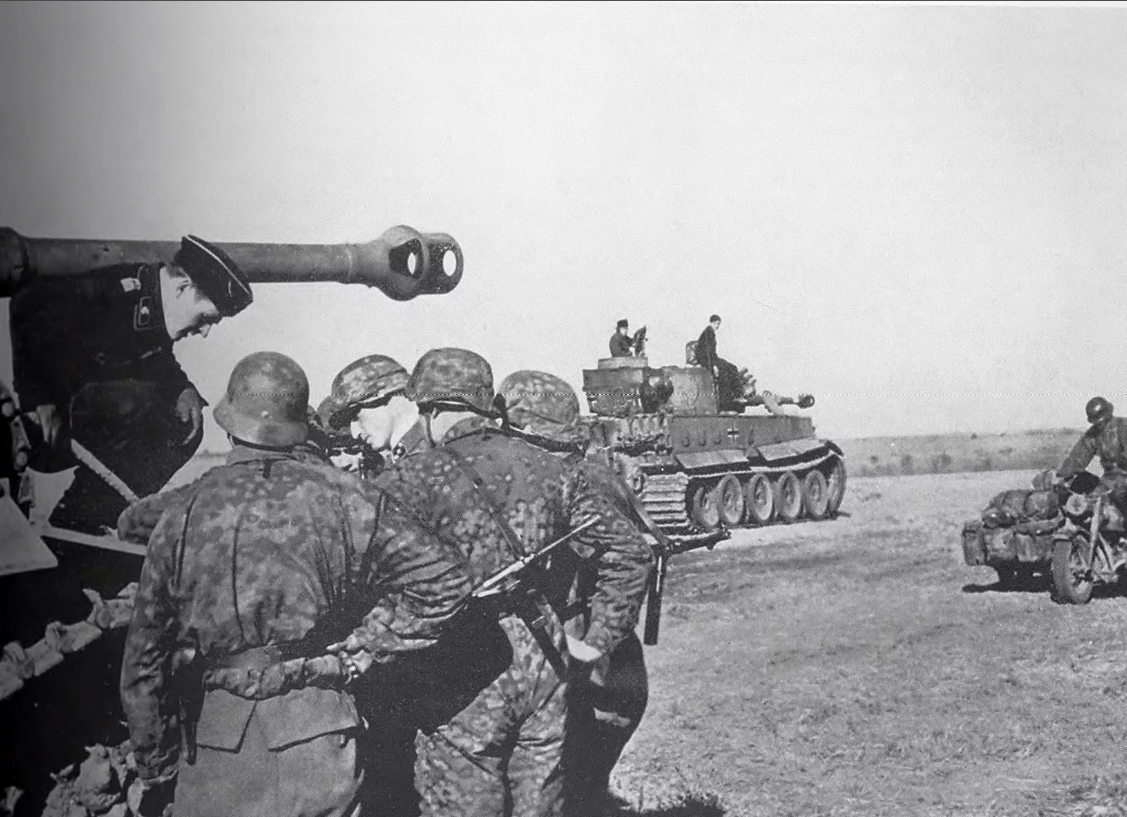
Kursk Battle – German Troops
Manstein, who was waiting for the Red Army to strike across the river. Donets in the direction of the Dnieper in order to cut off and destroy the Army Group “South”, considered it necessary to transfer it to strategic defense. Back in February 1943, he proposed to wait for the start of this offensive and, in the phase of its development, launch a series of flank counterattacks. Hitler, expecting political complications as a result of the transition to the defensive and wishing to keep the Donbass at all costs, rejected this plan. On March 10, Manstein proposed another plan, which was to “cut off” the Kursk salient with a rapid offensive immediately after the end of the spring thaw. The offensive was planned on a strip with a length of 1200 km, but already in February of P. M. Fitin became aware of the plans of the German command: reports on this matter came from England, from the “Cambridge Five”. The report of agent John Cairncross allowed the Red Army to build anti-tank defenses and concentrate its tank forces. Information was also received from the Berlin agent Chernyak, who became the prototype of the legendary Stirlitz: not only German operational plans were received, but also voluminous information on the latest Nazi tanks “Tiger” and “Panther”.
On 15 April, Hitler ordered the start of the offensive at Kursk (Zitadelle) on or shortly after 3 May. A prerequisite for the success of the operation was considered to be its beginning before the Red Army could prepare echeloned defensive positions or launch its own offensive. According to the plan of operation, the Army Group Center was to strike from the north with the forces of 9 A under the command of V. Model, and the Army Group South – from the south, with the forces of the 4th Panzer Army under the command of G. Hoth and an army group under the command of V. Kempf. The encirclement ring was planned to close on the hills east of Kursk. Parts of the Red Army, occupying the front in the western part of the ledge, were supposed to hold back the 2nd Army under the command of V. Weiss.
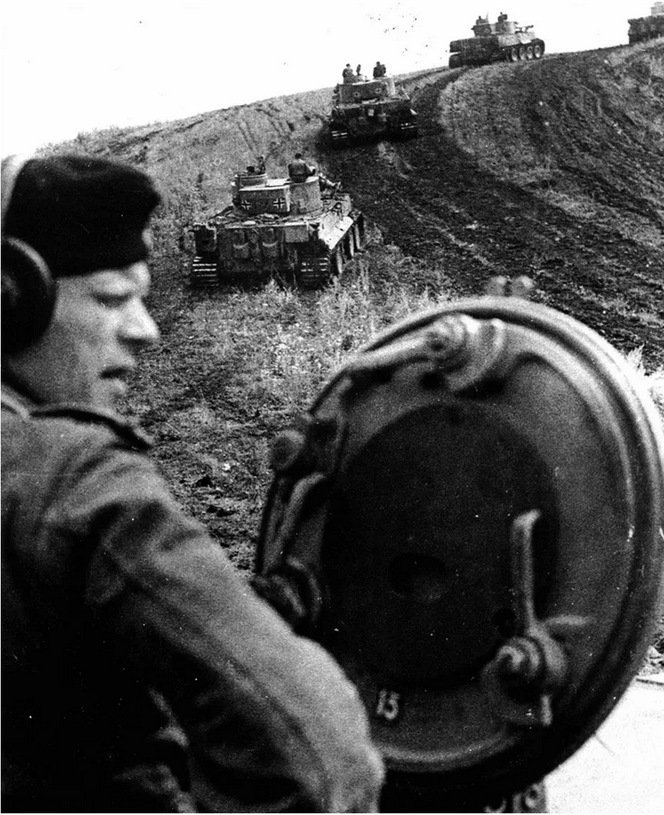
Advancing Panzers
At a meeting with Hitler on April 27, Model expressed concern about intelligence reports about the construction by the enemy of very strong defensive positions on the northern and southern faces of the Kursk salient and about the withdrawal of the mobile formations of the Red Army, previously located west of Kursk. Pointing out that further delay in preparations could deprive the offensive of any sense, Model recommended either to radically revise the plan of the operation, or to cancel it altogether and try to defeat the Red Army during its expected offensive. In any case, he believed that his 9th Army was completely unprepared for the offensive and demanded that it be saturated with the latest tanks. By the beginning of May, Manstein also joined this opinion of the Model, who, back in mid-April, considered the planned operation to be fully justified. Now he, too, proposed to switch to a strategic defense and, retreating in order to expose the flanks of the advancing enemy forces, to rely on tank counterattacks. Without doubting that the Red Army would direct the main blow against Army Group South, Manstein proposed to strengthen the left wing of the group, and with the right wing to carry out a phased retreat to the Dnieper, followed by a strike of the left wing on the flank of the advancing enemy and access to the Sea of Azov, which allowed to cut off and surround the advancing units of the Red Army. However, this plan was rejected by Hitler, who did not want to retreat so far, even temporarily.
At meetings in Munich (May 3 and 4, 1943), they decided whether Army Groups South and Center of the Eastern Front should launch an offensive in the near future (summer 1943). G. Guderian notes:
“This issue was discussed at the suggestion of the Chief of the General Staff, General Zeitzler. With this blow, he wanted to weaken the offensive impulse of the Russian army to such an extent as to create favorable conditions for the German high command to continue waging war in the east. This issue was hotly discussed back in April, but then, immediately after the disaster at Stalingrad and after the ensuing defeat on the southern sector of the Eastern Front, hardly anyone could think of major offensive actions. But now the chief of the general staff wanted to use the new tiger and panther tanks, which, in his opinion, should bring decisive success, seize the initiative again.
- Model believed: “the enemy is counting on our offensive, therefore, in order to succeed, you need to follow a different tactic, and even better, if you refuse to attack at all.” Manstein noted that the offensive would have been successful if it could have been launched in April; now he doubts his success. Hitler turned to Field Marshal von Kluge, who spoke directly in favor of Zeitzler’s proposal.
Guderian sums it up: “Speer supported my arguments regarding armaments. But only the two of us were the only participants in this meeting who answered Zeitzler’s proposal with a clear “no”. Hitler, who was not yet fully convinced by the supporters of the offensive, did not come to a final decision that day. Three days later, the start of the operation was postponed to June 12. On May 10, at a meeting in Berlin, Guderian addressed Hitler: “Why do you want to launch an offensive in the east this year?” Here Keitel intervened: “We must launch an offensive for political reasons”. To which Guderian replied:
“Is it really necessary to attack Kursk this year or anywhere in the East? Do you think anyone knows where this Kursk is? No one in the world cares if we take this city or not. What makes us advance this year near Kursk or anywhere else on the Eastern Front?
Hitler assured Guderian that the final decision on the operation had not yet been made. However, a little later, at the May meeting of the leadership of the NSDAP, Hitler compared the situation on the Eastern Front with the plight of the party in 1932: “Then we won only thanks to stubbornness, which sometimes looked insane. We will also win today”.
As the start of the operation dragged on and pessimism about its outcome grew, German military propaganda was instructed by the OKW to present the planned operation as a counter-offensive with limited targets. On 18 June, the OKW proposed that the operation be canceled, with the release of forces into a strategic reserve for the defense of Italy, the Balkans and Germany itself. On the same day, Hitler replied that he “fully understood” the position of the OKW, but had already made up his mind. Two days later, the start of the operation was scheduled for 5 July.
According to A. M. Vasilevsky, the plan was not original:
the decision made provided for a major offensive operation in the summer against the grouping of Soviet troops located inside the Kursk Bulge, and to try to repeat the strategic plan, which could not be carried out in the early spring of 1943.
USSR
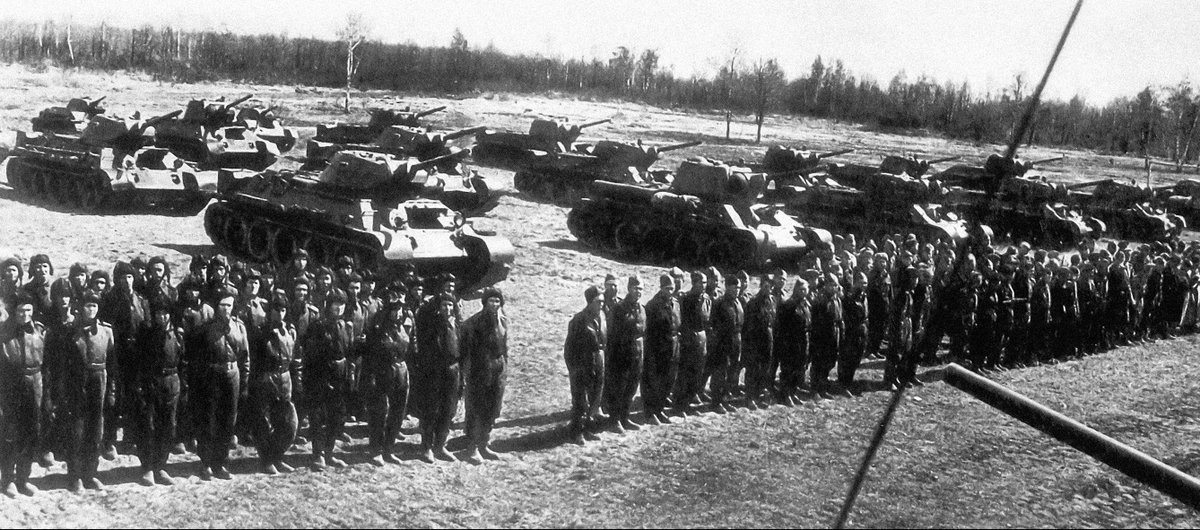
Kursk Battle – Soviet Tankers with their Vehicles
By the summer of 1943, the active army had 4.6 million people, and it was armed with 105 thousand guns and mortars, about 2200 rocket artillery installations, 10.2 thousand tanks and self-propelled guns, over 10.2 thousand combat aircraft. The presence of such large forces and means allowed the Soviet troops, who retained the strategic initiative, to launch a major offensive. His goal was to complete the emerging turning point in the war, defeat the Army Groups “Center” and “South”, liberate the Left-Bank Ukraine with the Donbass coal and metallurgical base and the eastern regions of Belarus, pushing the Germans behind the line of the Sozh River, the middle and lower reaches of the Dnieper.
Operational pause (April – June 1943)
The Soviet command began developing a plan for the upcoming actions and providing them with comprehensive support immediately after the end of the winter campaign – at the end of March 1943.
On April 8, 1943, G.K. Zhukov sent his report on possible military operations in the spring and summer of 1943 to the Headquarters. In it, Zhukov emphasized that the transition of the Soviet troops to the offensive in order to preempt the enemy was inexpedient: “It would be better if we exhaust the enemy on our defense, we will knock out his tanks, and then, introducing fresh reserves, by going over to the general offensive, we will finally finish off the main enemy grouping”.
Vasilevsky A.M. writes:
It seemed that we had done everything to organize our offensive. However, soon the plan of the summer offensive outlined by the Headquarters, which provided for the main attack in the South-Western direction, was significantly amended. Soviet military intelligence was able to timely reveal the preparation of the Nazi army for a major offensive on the Kursk Bulge and even set its date.
The Soviet command was faced with a dilemma: to attack or defend?
Plans and forces of the parties
The list of formations participating in the Battle of Kursk makes it possible to judge a large number of troops from both sides, concentrated by the summer of 1943 in the area of the Kursk bridgehead.
Germany
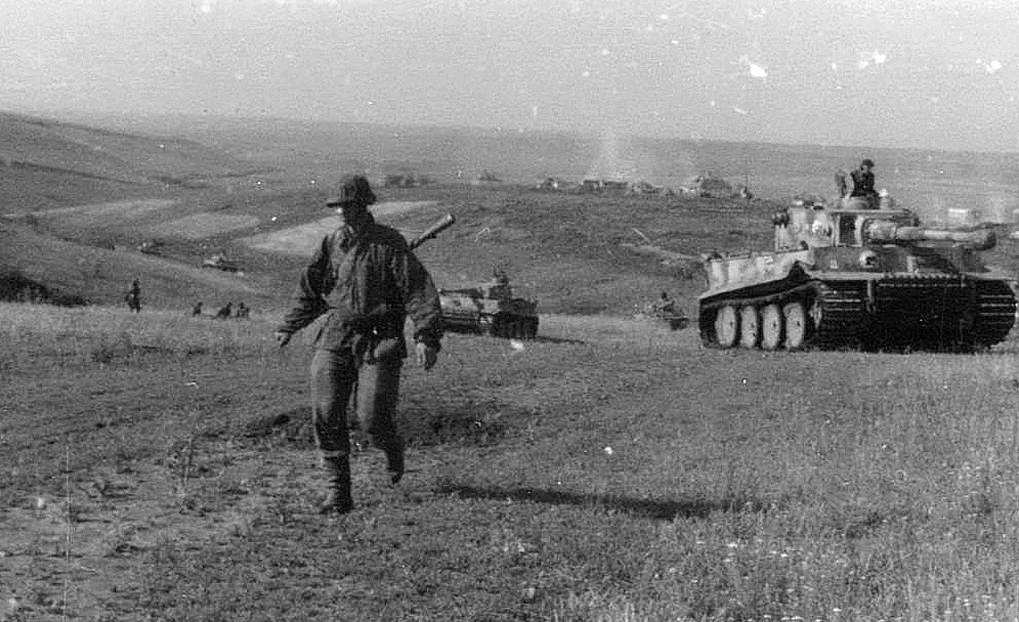
Kursk Battle – German Advance
The German command decided to conduct a major strategic operation on the Kursk ledge in the summer of 1943. It was planned to deliver converging strikes from the areas of the cities of Orel (from the north) and Belgorod (from the south). The strike groups were to link up in the Kursk region, surrounding the troops of the Central and Voronezh Fronts of the Red Army. According to the German General F. Fangor, at a meeting with E. Manstein on May 10 – 11, the plan was adjusted at the suggestion of General G. Goth: the 2nd SS Panzer Corps was tasked to turn around from the direction of Oboyan toProkhorovka, where the conditions of the terrain made it possible to deliver a massive blow to the armored reserves of the Soviet troops.
The name of the operation
The operation was provisionally named “Citadel”. The study by D. M. Projector notes:
The name of the plan of attack on the Kursk Bulge “Citadel”, taken from the terminology of the old fortress war, should have meant that the Third Reich, defending the “Fortress Europe”, with decisive sorties from this “citadel” exhausts the enemy besieging it and achieves victory over him.
–
Land grouping
For the operation, the Germans concentrated a grouping of up to 50 divisions (of which 34 were tank and motorized), 4 tank brigades, 6 separate tank battalions and 8 assault gun divisions, with a total strength, according to Soviet sources, about 1 million people. The leadership of the troops was carried out by Field Marshal G. H. von Kluge (Army Group Center) and Field Marshal E. Manstein (Army Group South). Organizationally, the strike forces were part of the 2nd Panzer, 2nd and 9th Armies (commander – Field Marshal V. Model, Army Group Center, Orel region) and 4th Tank Army, 24th Tank Corps and Operational Group Kempf (commander – General G. Goth, Army Group South, Belgorod region).
The 2nd SS Panzer Corps included several elite SS Panzer Divisions: 1st SS Panzer Division “Leibstandarte SS Adolf Hitler”, 2nd SS Panzer Division “Reich”, 3rd SS Panzer Division “Dead Head”.
The troops received a number of new equipment:
- 281 Pz.Kpfw.VI “Tiger” tanks (14 more – command tanks)
- 219 Pz.Kpfw.V “Panther” (11 more – evacuation and command)
- 100 assault guns Sd.Kfz. 184 Ferdinand
in total: 600 tanks and self-propelled guns of new types (Tiger, however, was used several times earlier: in late 1942 and early 1943). At the same time, however, a significant number (384 units) of frankly obsolete tanks (Pz.III, Pz.Kpfw.38(t) and even Pz.II) remained in the German units, as well as modernized ones with a long-barreled 75-mm gun Pz. IV.
Also during the Battle of Kursk, the German Sd.Kfz teletankettes were used for the first time. 302.
USSR
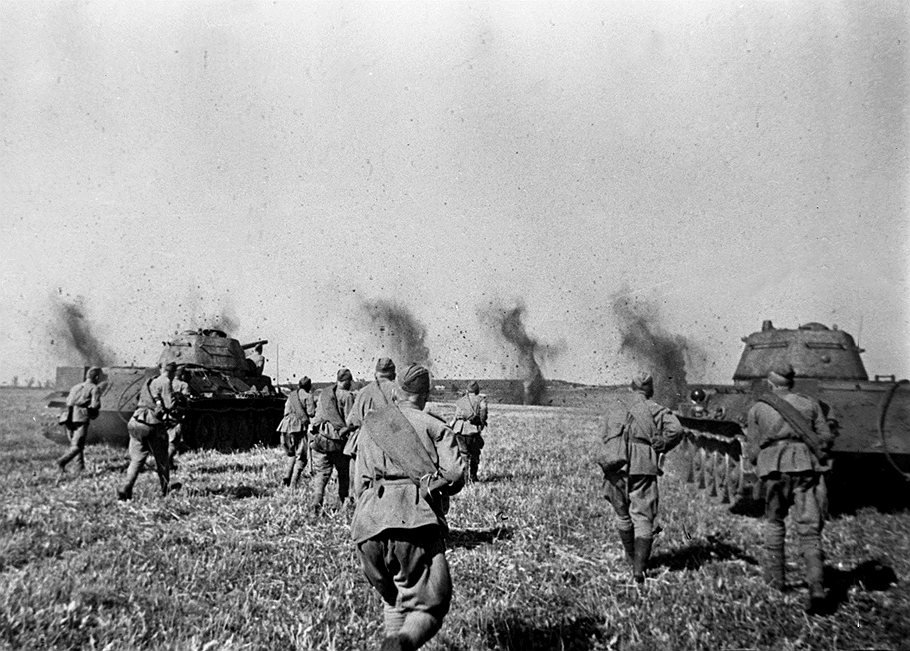
Kursk Battle -Soviet Troops Advancing
Zhukov’s considerations became the subject of a special meeting at Headquarters, which took place on April 12, 1943. It was attended by I.V. Stalin, Marshals G.K. Zhukov, A.M. Vasilevsky and Deputy Chief of the General Staff, General of the Army A.I. Antonov (this title was awarded to him on April 4, 1943).
In contrast to 1941-1942, in 1943, a powerful defense system was created by Soviet troops in the Kursk direction and it could be used. The Soviet command decided to conduct a defensive battle, wear down the enemy troops and inflict defeat on them, carrying out counterattacks on the attackers at a critical moment. To this end, a defense in depth was created on both faces of the Kursk salient. A total of 8 defensive lines were created. The average density of mining in the direction of the expected enemy strikes was 1,500 anti-tank and 1,700 anti-personnel mines per kilometer of the front.
The troops of the Central Front (commander – General of the Army K. K. Rokossovsky) defended the northern front of the Kursk ledge, and the troops of the Voronezh Front (commander – General of the Army N. F. Vatutin) – the southern front. The troops occupying the ledge relied on the Steppe Front (commanded by Colonel General I. S. Konev). The actions of the fronts were coordinated by representatives of the Headquarters of the Supreme High Command, Marshals of the Soviet Union G.K. Zhukov and A.M. Vasilevsky.
Assessment of the forces of the parties
In the assessment of the forces of the parties in the sources, there are strong discrepancies associated with the different definitions of the scale of the battle by different historians, as well as the difference in the methods of accounting and classification of military equipment. In assessing the forces of the Red Army, the main discrepancy is associated with the inclusion or exclusion from the calculations of the reserve – the Steppe Front (about 500 thousand personnel and 1500 tanks).
According to the authors of the 12-volume work “The Great Patriotic War of 1941-1945”, by the beginning of July, the Headquarters of the Supreme High Command concentrated “1336 thousand people in the Kursk direction (taking into account the rear units and institutions of the Central Fleet and the VF), 19.1 thousand guns and mortars (excluding reactive, anti-aircraft artillery and 50-mm mortars), 3444 tanks and self-propelled guns (including 900 light tanks), 2172 aircraft (including long-range aviation, the 17th air army of the SWF, night bombers – 2900 vehicles) “.
The following table contains some estimates:
| Source | Personnel (thousand) | Tanks and (sometimes) self-propelled guns | Guns and (sometimes) mortars | Aircraft | ||||
| USSR | Germany | USSR | Germany | USSR | Germany | USSR | Germany | |
| MO RF | 1336 | over 900 | 3444 | 2733 | 19100 | about 10000 | 2172 or
2900 (including Po-2 and far) |
2050 |
| Glantz, House | 1910 | 780 | 5040 | 2696 or 2928 | ||||
| Muller-Gil | 2540 or 2758 | |||||||
| Zett., Frankson | 1910 | 777 | 5128
+2688 “rate reserve” total over 8000 |
2451 | 31415 | 7417 | 3549 | 1830 |
| KOSAVE | 1337 | 900 | 3306 | 2700 | 20 220 | 10,000 | 2650 | 2500 |
Some authors show a smaller number of tanks, increasing the number of self-propelled guns – R. Icks gives 1081 German tanks along the southern front (SF) “of which half were represented by Pz Kpfw III tanks plus 376 assault guns (self-propelled guns)”, which gives a total of 1457 units armored vehicles. The editors of the book also recall the figures “Müller Hillebrand has 1493 tanks, including 190 obsolete” and “253 assault guns”, a total of 1746 units in the YuF.
The combat composition, the number of Soviet troops according to G. F. Krivosheev:
| Name of associations and terms of their participation in the operation | Combat composition and number of troops at the beginning of the operation | |
| number of connections | number | |
| Central Front (5.07.-11.07.43) | sd – 41, id – 1, mk – 4, sbr – 5, br – 3, UR – 3 | 738000 |
| Voronezh Front (all period) | sd – 35, mk – 1, mk – 4, br – 6 | 534700 |
| Steppe front (9.07.-23.07.43) | — | — |
| Total | Divisions – 77, corps – 9, brigades -14, UR-3 | 1272700 |
The role of intelligence
From the beginning of 1943, in the intercepts of secret messages from the High Command of the Nazi Army and in the secret directives of A. Hitler, Operation Citadel was increasingly mentioned. According to the memoirs of A. Mikoyan, on March 27, I. V. Stalin informed him in general details about the German plans. On April 12, the exact text of Directive No. 6 “On the Plan of Operation Citadel” of the German High Command, translated from German, was placed on Stalin’s desk, endorsed by all services of the Wehrmacht, but not yet signed by Hitler, who signed it only three days later.
There are several versions regarding the sources of information.
Soviet undercover intelligence
Cambridge Five
According to Lieutenant General Kirpichenko V.A:
The fact that the Germans read our, American or English correspondence is not recorded in any documents… But it is known reliably and for certain that the British read the correspondence of the German Wehrmacht.
One of the sources of information is called “… John Cairncross, an English codebreaker, one of the famous “Cambridge Five”, who collaborated with Soviet intelligence”.
Also Kirpichenko V.A. notes that:
John Cairncross at the end of April, more than two months before the start of the Battle of Kursk, gave Moscow full information that the German offensive would begin in early July. It was the decoding of a telegram to Berlin by the German general von Weichs, who was preparing a German offensive south of Kursk, in the Belgorod region. The telegram indicated exactly what forces the Germans would launch the offensive, when, what forces would operate from Orel, which — from Belgorod, what new equipment would be introduced. The location of German field airfields was indicated, etc., etc.
Reconnaissance group “Dora”
The “Dora” group of Sh. Rado reported to the Soviet command the most important information about the plans of the Wehrmacht and the deployment of the troops of the German army on the Eastern Front. There is also an opinion that information came to Moscow from Switzerland through a channel led by Rudolf Rössler.
front-line reconnaissance
Marshal Zhukov later claimed in his memoirs that he predicted the strength and direction of German attacks on the Kursk salient as early as April 8, based on intelligence data from the fronts of the Kursk direction.
British intelligence data
In early 1942, British intelligence managed to break the Lorenz code, which was used to encode messages from the top leadership of the Third Reich. The first practical result of this success was the interception of plans for a summer offensive on the Eastern Front. These plans were immediately handed over to the Soviet leadership. The intelligence transmitted to the USSR contained not only the direction of attacks on Kursk and Belgorod, but also the composition and disposition of the attacking forces, as well as the general plan of Operation Citadel.
Partisan actions
They made a significant contribution both to obtaining information about the movement of German troops, and to disrupting the supply of the Wehrmacht during the operation itself. For the first time supplied with a sufficient amount of explosives, the partisans, acting on the instructions of the Stavka, launched massive attacks on the railway tracks and the trains themselves. For example, only the partisan formation of A.F. Fedorov from July 7 to August 10 in the Kovel direction wrecked 123 trains.
Kursk defensive operation
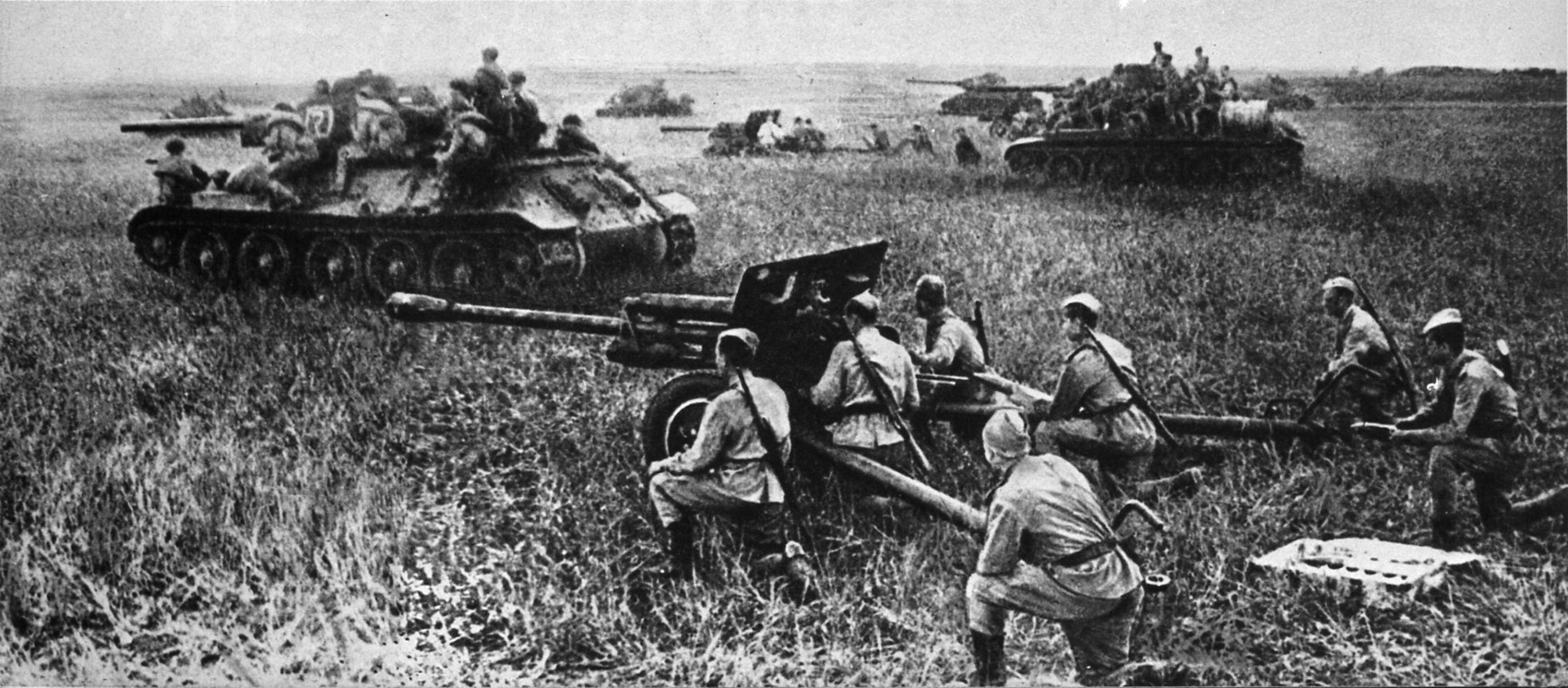
Kursk Battle Soviet Troops with Zis-3 Guns
The main military operations (Kursk strategic defensive operation) to repel the German summer strategic offensive (Operation Citadel) unfolded on the northern (Battle on the northern face of the Kursk salient) and southern faces of the Kursk salient. The German side failed to inflict dissecting blows on the grouping of Soviet troops in the western part of the Kursk Bulge (on the top of the ledge with the aim of subsequent encirclement). In order to weaken the initial blow of the German troops, the command of the Central Fleet and the VF developed a plan for artillery counter-preparation.
Artillery counter-training
Since March 1943, the organization of counter-training was in the center of attention of the command of both fronts, it was supposed to involve artillery and aviation in it. The plans for counter-preparation were continuously refined, with the final establishment of the concentration of the main enemy groupings in the initial areas for the offensive, it was planned to disrupt the offensive or decisively weaken the force of the initial German strike with powerful surprise artillery fire and air strikes.
The objects of suppression during the period of artillery counter-preparation were:
- accumulations of infantry and tanks, both reliably established and alleged
- batteries in firing positions and observation posts.
At the same time, the share of each of these objects on different fronts was not the same.
Central front
- I. Kazakov – commander of the artillery of the Central Front, speaking of counter- barrage preparation, noted that it:
was an integral and, in essence, the dominant part of the general counter-training, which pursued the goal of disrupting the enemy’s offensive.
In the zone of the Central Fleet (13A), the main efforts were concentrated on suppressing the enemy artillery grouping and observation posts (OPs), including artillery ones. This group of objects accounted for more than 80% of the planned goals. This choice was explained by the presence in the army of powerful means of combating enemy artillery, more reliable data on the position of his artillery group, the relatively small width of the expected strike zone (30-40 km), as well as the high density of combat formations of divisions of the first echelon of the troops of the Central Fleet, which led to their greater vulnerability to artillery strikes. By inflicting a powerful fire strike on German artillery positions and NP, it was possible to significantly weaken and disorganize the enemy’s artillery preparation and ensure the survivability of the troops of the first echelon of the army to repel the attack of attacking tanks and infantry.
Voronezh Front
In the VF zone (6th Guards A and 7th Guards A), the main efforts were aimed at suppressing infantry and tanks in the areas of their probable location, which accounted for about 80% of all targets hit. This was due to a wider zone of a probable enemy strike (up to 100 km), greater sensitivity of the defense of the first echelon troops to tank strikes, and fewer means of combating enemy artillery in the armies of the VF. It was also not excluded that on the night of July 5, part of the enemy artillery would change their firing positions when the combat outposts of the 71st and 67th Guards departed. sd. Thus, the gunners of the VF, first of all, sought to inflict damage on tanks and infantry, that is, the main attack force of the Germans, and suppress only the most active enemy batteries (reliably explored).
Fighting on the northern face of the Kursk Bulge
Before the start of the ground operation on July 5 at 6 am Moscow time, the Germans also launched a bombing and artillery attack on the Soviet defensive lines. The core of the German tank force was the Ferdinand self-propelled gun mount and medium Panthers. By the evening of the first day of the battle, 55% of the enemy self-propelled guns blown up by the mines of the Central Front of the Red Army were out of order. The tanks that went on the offensive immediately ran into serious resistance from the tank formations of the 2nd Tank Army of General A. G. Rodin (1902-1955). The main blow on the northern flank was struck on July 6 in the direction of Olkhovatka. Having not achieved success, the Germans on July 9 suffered a blow in the direction of the Ponyri railway station., but even here they could not break through the Soviet defenses. The T-34 tanks offered stubborn resistance to the German tanks that entered the rear, they were able to push the enemy back, passing with losses for 1.3 km. The grouping of V. Model on the northern flank was able to penetrate deeply only 10-12 km, after which, already on July 10, having lost up to two-thirds of the tanks, the 9th German Army went on the defensive.
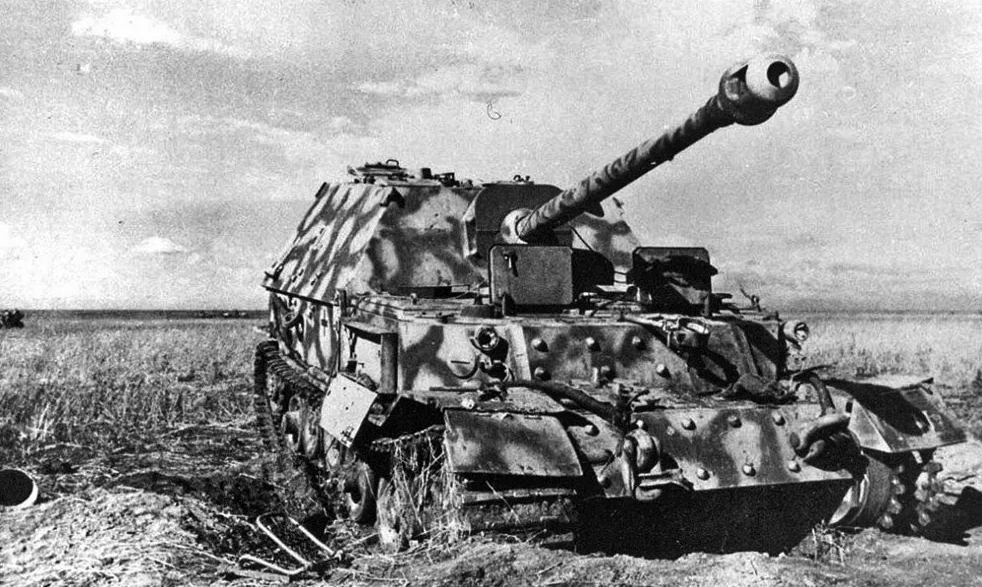
Ferdinand Tank Destroyer
Model’s plan to break through the three lines of defense of the Central Front of the Red Army was to strike the first blow with the forces of infantry divisions, reinforced with heavy tanks and assault guns, with the support of artillery and aviation. After breaking through the enemy’s defenses, the tank divisions were to develop their success in the direction of Kursk. In accordance with this plan, the 47th Panzer Corps, reinforced by the 505th battalion of heavy tanks “Tiger”, operated in the center – on the main direction of attack. To his left was the 41st Tank Corps with an attached regiment of self-propelled guns “Ferdinand”(83 vehicles). The left flank of the entire group was covered by the 23rd Army Corps, which consisted of three infantry divisions (including the reinforced 78th assault) with 62 assault guns. On the right flank, the 46th Panzer Corps operated, consisting of four infantry divisions, which, despite its name, had only 9 tanks and 31 assault guns.
In the first echelon of the offensive of the 47th TK, the 20th Panzer Division and the 6th Infantry Division, reinforced by two companies of “Tigers” (28 vehicles according to the state), were marching. Two tank divisions of the second echelon were to enter the gap and continue the offensive. The advance of the first echelon was slowed down by the resistance of the 15th Infantry Division of the Red Army in heavily fortified positions and the presence of a large number of mines. By 08:00, passages in the minefields were cleared. After interrogation of a captured Red Army soldier, it became known that there was a poorly defended position at the junction between the 15th and 81st divisions, where the German heavy tanks were redirected. In this place, the “Tigers” were counterattacked by T-34 tanks in the amount of about 90 units. In the ensuing three-hour tank battle, 42 T-34 tanks and two Tigers were destroyed, and five more Tigers were immobilized due to damaged tracks. Having beaten off this tank counterattack of the Red Army, the Germans broke through the first line of defense, however, in three hours of battle, units of the 29th Rifle Corps of the 13th Army, located behind the first line, moved forward and liquidated the gap in the front. The fire of the artillery of the Red Army greatly hampered the work of German sappers in clearing passages in minefields, even when they used remotely controlled demining equipment (“Goliath” and Borgward IV). By 17:00, out of 45 self-propelled guns “Ferdinand” of the 653rd heavy anti-tank battalion, 33 vehicles lost their course due to mine explosions. Subsequently, most of these self-propelled guns were repaired, however, the evacuation of such heavy equipment from the battlefield was fraught with considerable difficulties.
During the first day of the offensive, the 47th TK was able to advance almost 10 km deep into the defenses of the Red Army, and the 41st TK went to the heavily fortified village of Ponyri, through which the second line of Soviet defense passed, as well as the highway and railway leading to Kursk. The losses of the Wehrmacht amounted to 1287 people killed and missing, as well as 5921 people wounded.
The next day, the 17th and 18th Guards Rifle Corps of the Red Army, as well as the 2nd Tank Army and the 19th Tank Corps, in accordance with the order received earlier, were to counterattack the 9th German Army. However, due to poor coordination of actions at dawn on July 6, only the 16th tank corps of the 2nd tank army, which had about 200 tanks, went on the offensive after artillery preparation. The blow fell on the positions of the 47th TK and was met by Tiger tanks from the 505th heavy tank battalion. Having lost 69 tanks in battle, the 16th Tank Corps withdrew to the positions of the 17th Guards Rifle Corps of the 13th Army around the village of Olkhovatka, through which the second line of defense passed.
After that, the 47th TC, also after carrying out artillery preparation, attacked itself in the direction of Olkhovatka, pushing forward the 24 Tigers remaining in the ranks. This attack was repulsed with heavy losses for the Germans. At 18:30, the 19th Tank Corps of the Red Army entered the position of the 17th Guards Rifle Corps, further strengthening the defense. In addition, on the orders of Rokossovsky, most of the serviceable tanks were placed in special trenches, which reduced their vulnerability. Simultaneously with Olkhovatka, Ponyri, defended by the 307th Rifle Division of the 29th Rifle Corps of the Red Army, were attacked. This attack was carried out by the forces of one tank and three infantry divisions of the Wehrmacht (9 TD, 292nd and 86th Infantry Division, 78th Assault Division, respectively), however, it was not possible to dislodge the Ponyry defenders from their heavily fortified positions.
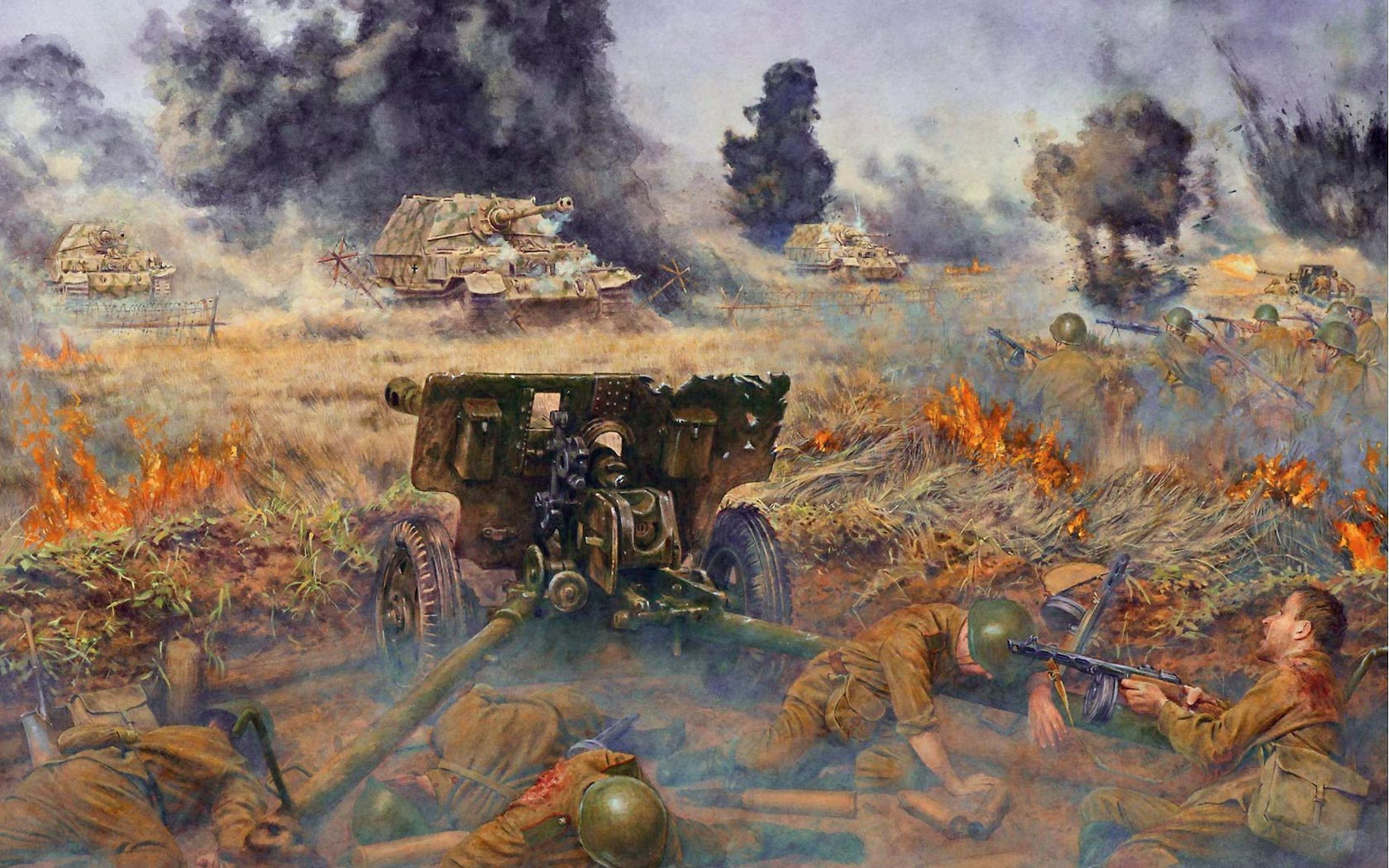
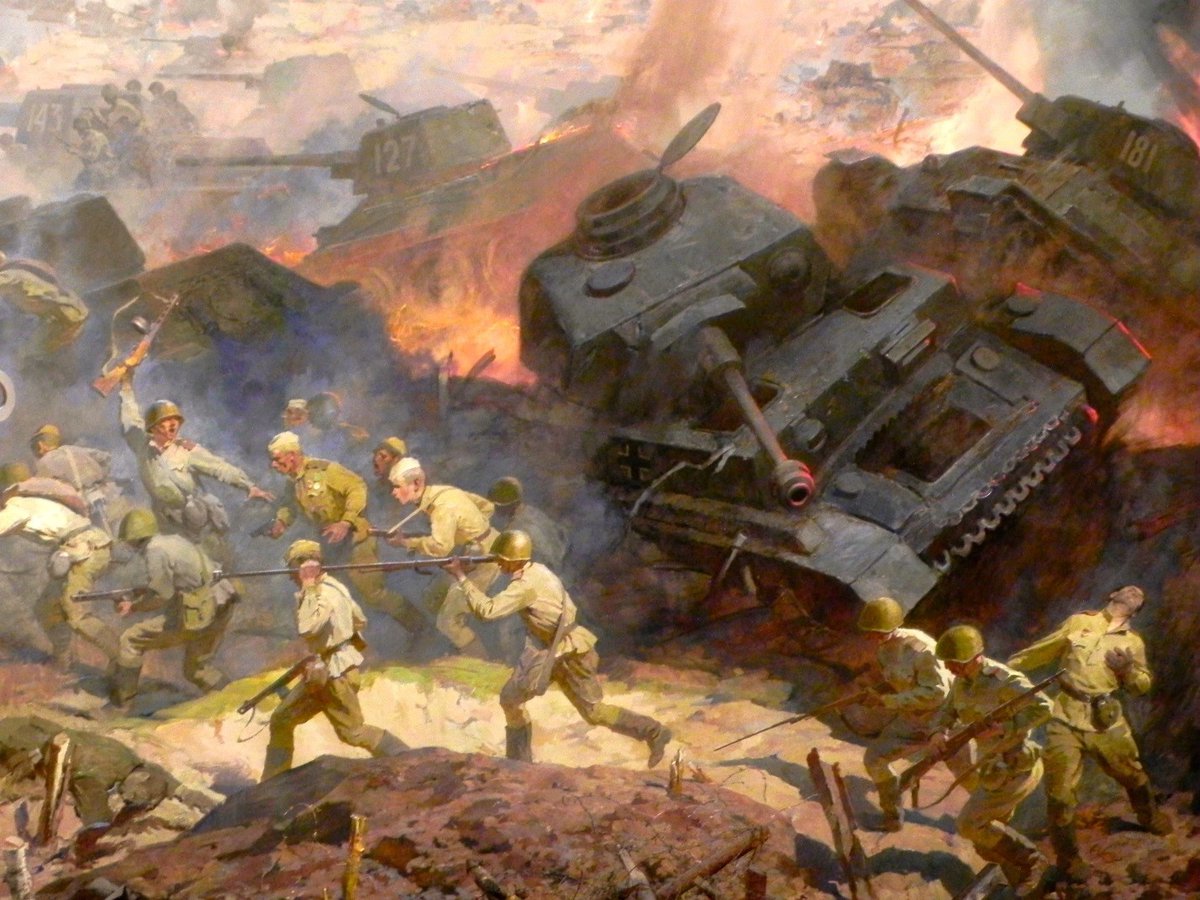
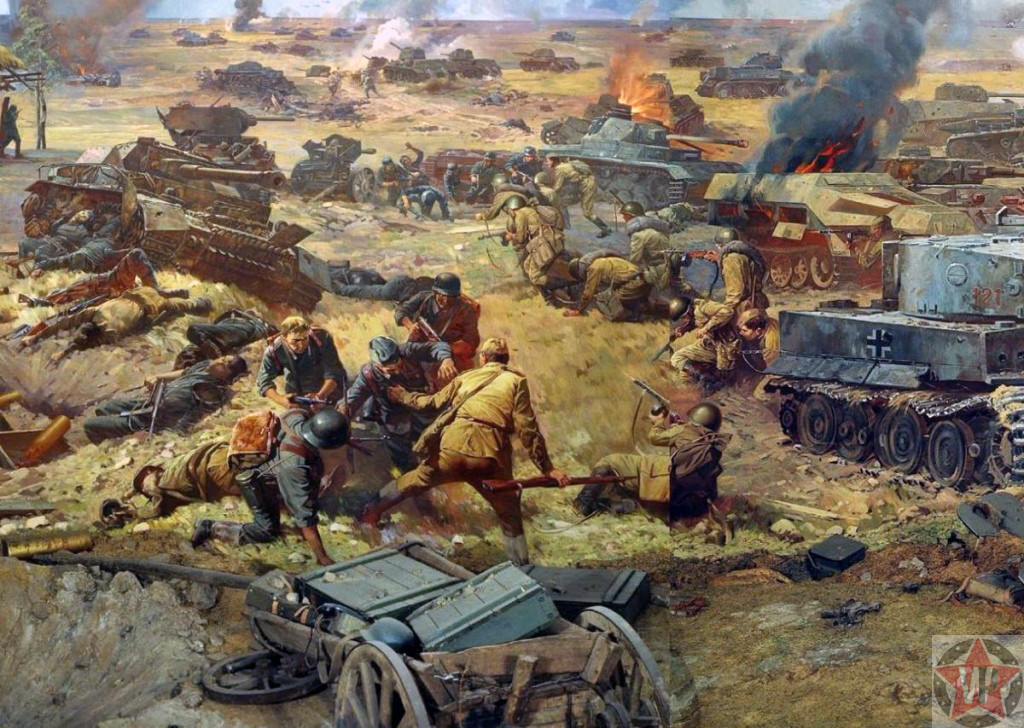
Over the next three days (July 7-10), Model directed all the forces of his 9th Army to capture Ponyri and Olkhovatka, the importance of which became obvious to both sides in the battle. Rokossovsky also pulled forces from other sectors of the front to these settlements. Attacking Ponyri on July 7, the Germans captured half of the village after heavy street fighting. The next morning, the Germans were driven out of Ponyri by a counterattack of the Red Army. After that, the settlement changed hands several times. By July 10, the Germans were able to capture almost the entire village, but the counter attacks of the Red Army did not stop. Military operations near Ponyri and nearby height 253.5 acquired the character of a war of attrition with heavy losses on both sides. German attacks on Olkhovatka (and the village of Tyoploye) also failed to break through the defenses of the Red Army. The very powerful offensive on July 10, carried out with the involvement of about 300 tanks and assault guns from the 2nd, 4th and 20th Panzer divisions of the Wehrmacht and supported by all the forces of the Luftwaffe that were available in the area of the northern face of the Kursk Bulge, turned out to be unsuccessful as well.
At a meeting at the headquarters of the 47th Panzer Corps, held on July 9th with the participation of Kluge, Model, Lemelsen and Harpe, the impossibility of breaking through the Soviet defenses by the forces of the 9th Army was stated. The German command had no doubt that the enemy also understood this. Despite this, Kluge wanted to continue to put pressure on the Soviet defense in order to alleviate the situation of the Wehrmacht and SS units advancing on the southern face of the Kursk salient.
The German offensive on the northern face began on a front 45 km wide. The next day, the offensive front was reduced to 40 km, on the third day – to 15 km. On July 8 and 9, the Wehrmacht advance front was only 2 km. On July 10, the offensive was completely stopped.
On July 12, the Red Army launched an offensive (“Operation Kutuzov”) with the creation of a threat to the flank and rear of the 9th Army of the Model. To repulse it, the Germans had to transfer and bring into battle the 12th Panzer Division, which was a reserve for the development of the offensive on Kursk, as well as the 36th Motorized, 18th and 20th Panzer Divisions.
Defensive operation in the Belgorod-Kursk direction
The German offensive began on the morning of July 5, 1943. Since the Soviet command knew exactly the start time of the operation – 3 am, at 22:30 and 2:20 Moscow time the forces of the two fronts carried out counter-barrage preparation with the amount of ammunition of 0.25 ammunition. On the southern front, the main blows of the Germans were directed to the areas of Korocha and Oboyan.
Periodization of the Battle on the southern face of the Kursk Bulge
Zamulin V.N. notes:
In 1945, the work of senior officers and generals of the General Staff “The Battle of Kursk. Brief essay” In it, the authors for the first time gave a periodization of the battle, which fairly accurately reflects the essence of what was happening.
… Undoubtedly, the battle of Prokhorovka was the culminating moment of the Kursk defensive operation on the southern front, after which the tension of the battles dropped sharply. However, the dissertation emphasizes that it is not necessary to equate the Prokhorov battle, which took place from July 10 to 16, 1943, and the tank battle near the station on July 12, 1943. The battle became only a part, albeit an important one, of this battle. The offensive of the GA “South” was thwarted by the joint efforts of the troops of the Voronezh Front and the reserve of the Headquarters of the Supreme High Command.
The main periods of the Battle on the southern face of the Kursk salient are also mentioned by L. N. Lopukhovsky:
… I do not quite agree with the periodization of the Kursk defensive operation proposed in 1945 in the work of the General Staff: 1st stage – battles in the Oboyan direction on July 5-9; 2nd – battles near Prokhorovka July 10-12; 3rd – battles in the area of Leski, Gostishchevo, Shakhovo July 13-15; 4th – counteroffensive to restore the situation on July 17-25. The fighting in the area of Gostishchevo, Leski and Shakhovo began on July 11 and continued simultaneously with the battles near Prokhorovka, so it is inappropriate to separate them into a separate stage.
The first in the open press to propose expanding the time frame of the Prokhorov battle, highlighting it as a separate stage of the front operation – from July 10 to 15, 1943, retired Major General G. A. Oleinikov – a participant in those battles.
Battles in the Prokhorovka sector July 10-12
Having failed in the Oboyan direction, the German command is concentrating its efforts on the Prokhorovka direction, meaning the continuation of the strategic offensive along the more circuitous route Prokhorovka-Kursk. The capture of the Prokhorovka area was planned to be carried out by two coordinated strikes:
- the main group – from the district of Kr. October, Greznoe, Kr. Polyana – along the highway to Prokhorovka;
- 3TK – from the Melehovo district to the Upper. Olshanets and further north – to Prokhorovka.
Simultaneously with the solution of the main task (exit to the Prokhorovka district), the Germans intended to encircle 69A, thereby significantly expanding the “bag” formed during the offensive to the east.
The Germans attacked Prokhorovka on July 11:
- from the west (by the forces of the main group);
- from the south (by 3TK forces).
The main task of the VF during this period was a staunch defense and maximum exhaustion of the enemy. In the work of the General Staff it is noted:
July 11 can be regarded as the day of the beginning of the great battle for Prokhorovka.
As a result of stubborn battles that unfolded west of Prokhorovka, the German strike force, consisting of more than 150 tanks and infantry, reached the Sovkh district by the end of the day. Oktyabrsky, sovkh. Stalin’s department Parts of the 3TK, advancing from the district of Melekhov, went to the district of V. Olshanets.
On July 12, the battle in the Prokhorovka direction reached its highest point. Troops of the VF, reinforced by the 5th Guards. TA and 5 Guards. And they delivered a front-line counterattack, which had the goal of defeating the advancing grouping and depriving it of the possibility of a further strategic offensive on Kursk.
July 12 – the culmination of the big battle near Prokhorovka
On July 12, in the Prokhorovka area, the largest (or one of the largest) head-on tank battle in history took place. The Germans made two strong attacks on Prokhorovka, from the west and from the south. The enemy, having concentrated to the west of Prokhorovka up to four tank and up to one infantry division, threw them along the highway to the east. In addition, a 3TK attack consisting of 300 tanks was aimed at Prokhorovka from the south. On July 12, two tank battles unfolded, one in the area west of Prokhorovka, in which the main forces of the 5th Guards took part. TA and the main German grouping consisting of three divisions of the SS Panzer Corps and the 17th Panzer Division. Other – in the area of Ryndinka, Rzhavets, Vypolzovka, where tank units from the 5th Guards collided. TA – detachment of the gene. Trufanov (three tank brigades) and the main forces of the 3TK (three tank divisions). According to the report of the intelligence department (RO) of the headquarters of the VF, in two areas where the troops of the 5th Guards were operating. TA:
The enemy up to three regiments of motorized infantry, with the support of up to 250 tanks of the tank divisions “Adolf Hitler”, “Reich” and “Dead Head” from the line Charming – Yamki and up to two motorized regiments with a group of tanks up to 100 units from the line Krivtsovo – Cossack went on the offensive in general direction to Prokhorovka, trying to surround and destroy parts of 69A
– TsAMO RF. F. 203. Op. 2843, D. 452, L. 95.
- N. Zamulin notes that “after the end of the defensive operation, on July 24, 1943, a member of the Front’s Military Council, Lieutenant-General N. S. Khrushchev, included the RO data in his report “On the tank battle on July 12, 1943 in the area Prokhorovka of the Kursk region“ addressed personally to I. V. Stalin”.
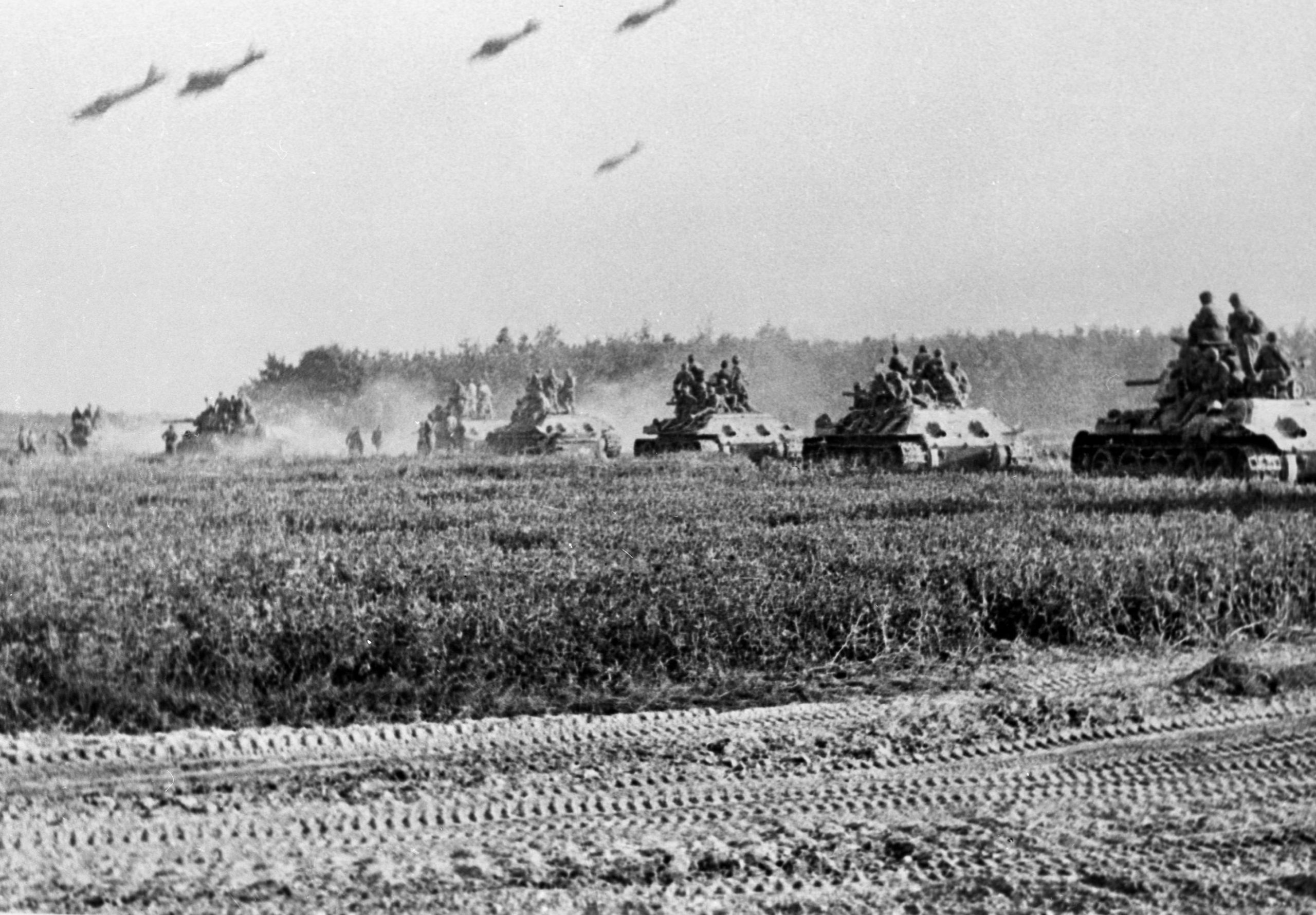
Kursk Battle – Soviet Tanks Moving To Battle
On the evening of July 11, 297 units were in service in the 2TK SS. armored vehicles (239 tanks and 58 assault guns); in three divisions and 503 baht. “Tigrov” 3TK – 119 (100 tanks and 19 assault guns). Moreover, according to V. Zamulin, there were “no more than 30-35 tanks and assault guns out of the available 122” from the motorized division (MD) of the SS “Dead Head” here. The rest (77 – 82 armored vehicles) operated in the bend of the river. Psyol, in the band of the 5th Guards. A., as noted on the “important German bridgehead, created on July 10-11 across the river. Psyol.” From the Soviet side, to this bridgehead (the right flank of the 5th Guards TA, north of the station) “only two brigades were transferred, numbering 92 tanks”.
According to data from Soviet sources, about 700 tanks and assault guns participated in the battle from the German side. On the Soviet side, the 5th Guards Tank Army of P. Rotmistrov participated in the battle, numbering, according to the report, 793 tanks. According to V. Zamulin:
Combat reports give the figure of 808 serviceable tanks. The error is related to the imperfection of accounting for armored vehicles transferred from the rem services to the troops.
Grigory Penezhko, a participant in the battle, deputy chief of staff of the 31st brigade, later Hero of the Soviet Union, recalled the state of a person in those terrible conditions:
Heavy pictures remained in my memory… There was such a roar that the membranes pressed, blood flowed from the ears. The continuous roar of engines, the clanging of metal, the roar, the explosions of shells, the wild rattle of torn iron… From point-blank shots, turrets turned, twisted guns, armor burst, tanks exploded.
From shots into gas tanks, the tanks instantly flared up. Hatches opened, and tank crews tried to get out. I saw a young lieutenant, half burnt, hanging from his armour. Wounded, he could not get out of the hatch. And so he died. There was no one around to help him. We lost the sense of time, we felt neither thirst, nor heat, nor even blows in the cramped cockpit of the tank. One thought, one desire – while alive, beat the enemy. Our tankers, who got out of their wrecked vehicles, searched the field for enemy crews, also left without equipment, and beat them with pistols, grabbed them hand-to-hand. I remember the captain, who, in some kind of frenzy, climbed onto the armor of a padded German “tiger” And hit the hatch with a machine gun in order to“ smoke out ”the Nazis from there. I remember how bravely the commander of the tank company Chertorizhsky acted. He knocked out the enemy “Tiger”, but he himself was shot down. Jumping out of the car, the tankers put out the fire. And they went into battle again.
By the end of July 12, the battle was over. The main goal of the counterattack of the Voronezh Front by the forces of the 5th Guards. TA and 5th Guards. Ar., did not reach. The enemy was not defeated, but the further advance of the formations of the 2nd SS Panzer Corps near Prokhorovka was stopped. Having advanced 35 kilometers over July 5-12, Manstein’s troops were forced, having trampled on the achieved lines for three days in vain attempts to break into the Soviet defenses, to begin the withdrawal of troops from the captured “bridgehead”. During the battle there was a turning point. The Soviet troops, which went on the offensive on July 17, pushed back the German armies in the south of the Kursk Bulge to their original positions by July 23.
Losses
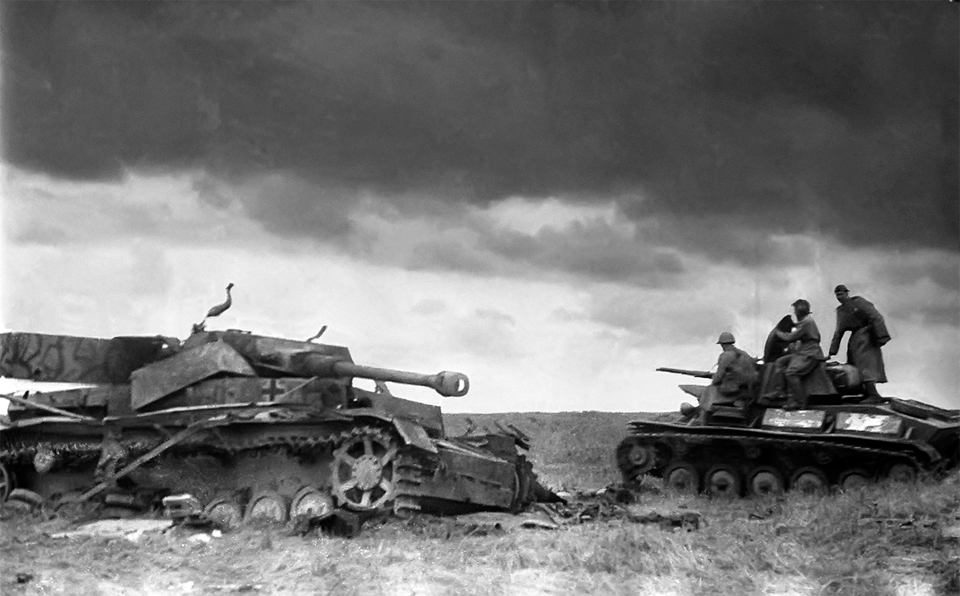
Destroyed German Armor
According to Soviet data, about 400 German tanks, 300 vehicles, over 3,500 soldiers and officers remained on the battlefield in the battle of Prokhorovka. However, these numbers are being questioned. For example, according to the calculations of G. A. Oleinikov, more than 300 German tanks could not take part in the battle. According to the research of A. Tomzov, referring to the data of the German Federal Military Archive, during the battles of July 12-13, the Leibstandarte Adolf Hitler division irrevocably lost 2 Pz.IV tanks, 2 Pz.IV tanks and 2 Pz.III, in the short term – 15 tanks Pz.IV and 1 Pz.III. The total losses of tanks and assault guns of the 2nd SS Panzer Corps on July 12 amounted to about 80 tanks and assault guns, including at least 40 units lost by the Totenkopf Division.
At the same time, the Soviet 18th and 29th Tank Corps of the 5th Guards Tank Army lost up to 70% of their tanks. L. N. Lopukhovsky writes that “the Germans, who controlled the battlefield (including visually), estimated our losses that day at 244 tanks”.
Fights 69A and 5 Guards. TA in the area of Rzhavets, Leski, Gostishchevo (July 13 – 15)
By July 13, the German troops, significantly drained of blood during the failed strategic attack on Kursk from the south, went over to the defensive in front of the entire Voronezh Front, with the exception of strip 69A. The German command, seeking to extract some benefit from the current situation, set a particular task for the 3TK and 2TK SS – to surround five 69A divisions defending in a narrow ledge between the Lipovy Donets and Seversky Donets rivers, and eliminate this ledge.
The operation plan was prepared in less than a day. The corresponding orders were brought to the units in the last hours of July 13, and the offensive began at 04:00 on July 14. At dawn on July 14, after a short artillery preparation, the 4th regiment of the Das Reich divisionattacked a hill in the south-west of the village of Pravorot and after heavy fighting for each house, turning into hand-to-hand combat, drove out the remnants of the 2nd Guards. Tatsinsky shopping mall from the village of Belenikhino. After several unsuccessful counterattacks, units of the Red Army withdrew to the east with the occupation of a new line of defense, reinforced by order of Zhukov, the 10th Guards Mechanized Brigade of the 5th Guards Mechanized Corps. Ultimately, the 7th TD 3TK of the Wehrmacht connected with the Das Reich division, however, before that, having correctly assessed the emerging situation, the commander of 69A gave the order to withdraw with battles. Thus, the main goal of the operation was not achieved, only a significant amount of anti-tank artillery of the 69th Army remained in the encirclement. After receiving the appropriate orders at the end of the day on July 15, the Totenkopf TD began to withdraw from its positions north of the Psel River, and the 2TK SS went on the defensive along the entire occupied sector of the front.
Counteroffensive of the Voronezh and Steppe fronts (July 17-23).
On July 15, the enemy exhausted his offensive capabilities, bled dry as a result of the stubborn resistance of the troops of the VF, he was forced to stop active operations and go on the defensive.
Battles of forward detachments on July 17 and 18
On the basis of intelligence data, the commander of the VF already on the morning of July 17 makes an assumption about the possibility of an enemy withdrawal and gives an order for reconnaissance by strong forward and reconnaissance detachments. By the end of July 17, the forward detachments of the 6th Guards. A and 5 Guards. TA advanced 2-5 km and occupied the Sitnoye tract, the Komsomolets state farm and Storozhevoye. On July 18, troops of the 1st and 5th guards. TA part of the forces went on the offensive; troops of the 5th Guards. And they took control of Red October, Bogoroditsky, Kozlovka.
The offensive of the Voronezh and Steppe fronts on July 20-23.
On July 18, the Headquarters of the Supreme High Command ordered a general counteroffensive in order to eliminate the enemy troops that had penetrated, meaning the further development of the offensive to defeat the Belgorod-Kharkov group of Germans.
On the basis of the directive of the Headquarters of July 16, from 11 pm on July 18, the Steppe Front, made up of the 53rd, 47th and 4th Guards Armies, as well as from the 69th and 7th Guards Armies transferred from the VF, is put into action.
On July 19, the troops of both fronts, continuing to conduct reconnaissance, regrouped.
By the end of July 23, the troops basically reached the line, which had been occupied before the Germans went on the offensive. In certain sectors of the front, where the troops did not reach this milestone, offensive battles continued until the first days of August. The troops of the Steppe Front cleared the entire eastern bank of the river from the enemy. Seversky Donets.
“Panfilov” of the Fiery Arc
On August 17, 1943, the armies of the Steppe Front (SF) approached Kharkov, starting a battle on its outskirts. The 53rd army of I.M. Managarov acted vigorously, especially its 89th guards. sd colonel M. P. Seryugin and 305 sd colonel A. F. Vasiliev. Marshal G.K. Zhukov in his book “Memories and Reflections” wrote:
The most fierce battle unfolded over the height of 201.7 in the Polevoy area, which was captured by the consolidated company of the 299th Infantry Division, consisting of 16 people under the command of Senior Lieutenant V.P. Petrishchev. When only seven people remained alive, the commander, turning to the fighters, said: – Comrades, we will stand on a height as the Panfilovites stood at Dubosekov. We will die, but we will not retreat!
And they didn’t back down. The heroic fighters held the height until the division’s units approached. For courage and heroism, by the Decree of the Presidium of the Supreme Soviet of the USSR, senior lieutenant V.P. Petrishchev, junior lieutenant V.V. Zhenchenko, senior sergeant G.P. Polikanov and sergeant V.E. Breusov were awarded the title of Hero of the Soviet Union. The rest were awarded orders.”
– Zhukov G.K. Memories and reflections.
Platoon of Heroes of Romanovsky
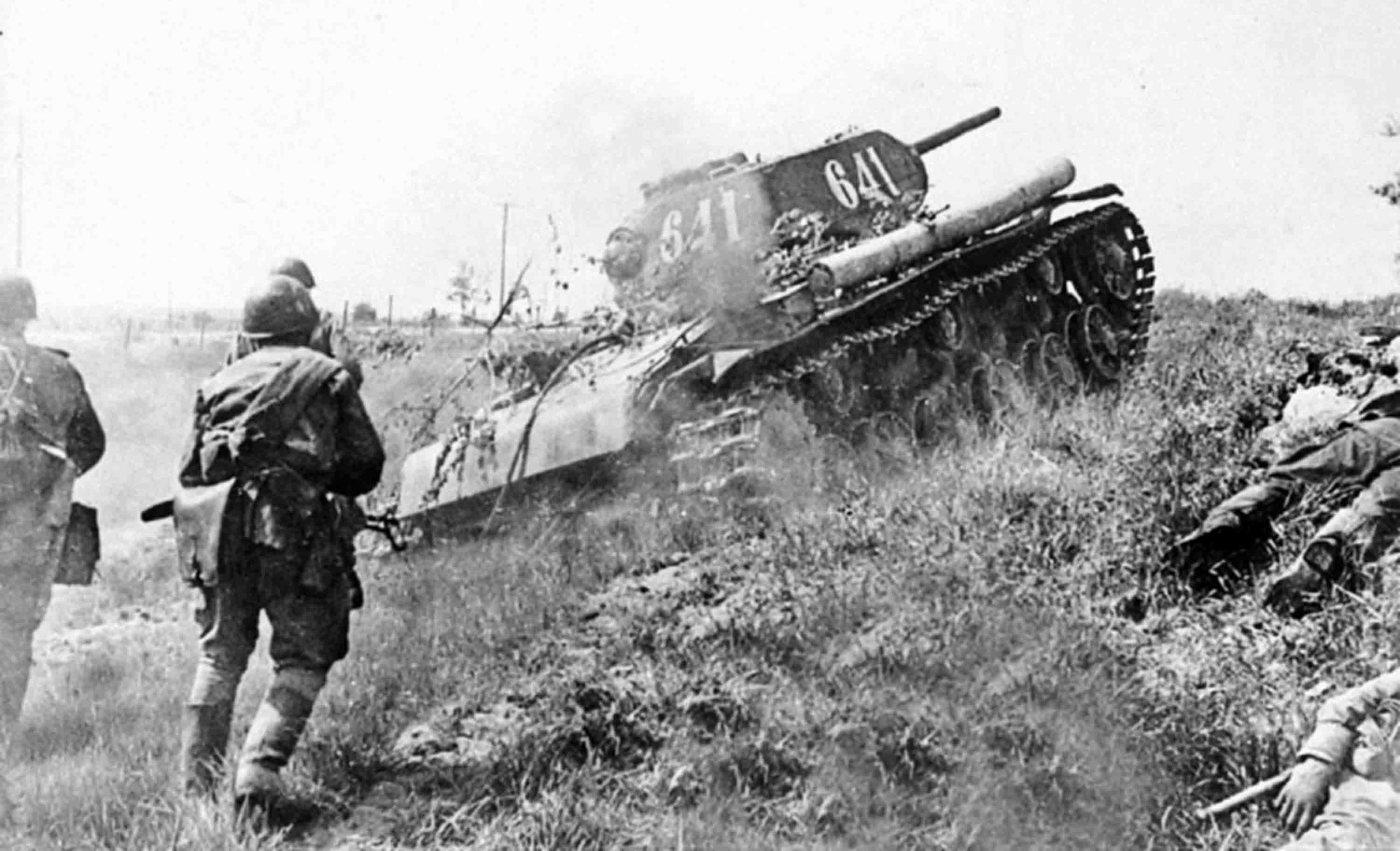
Soviet Kv1 Attacking With Infantry
Parts of the 162nd sd, in which many border guards from the Central Asian border district served, along with tankers of the 19th tank corps south of the village. Warm reflected from 11 to 13 July, repeated attempts by the Germans to break through the defense. But the troops of the Central Fleet were already preparing for offensive battles. The 70A command was developing a counterattack to restore the position occupied before July 5. Together with the tankers, the 224th Pamir Rifle Regiment took possession of the village in a fierce short battle. Warm. Having driven back the remnants of the Germans, the regiment advanced to a height north of this settlement. To cover the flank of the regiment, a platoon of Lieutenant Alexander Romanovsky was assigned from the 3rd company of the 1st battalion. Having completed the preparation, the regiment’s units attacked the Germans in the village of Samodurovka.
Taking advantage of the small number of flanking guards of the advancing regiment, the Nazis counterattacked the platoon of Lieutenant Romanovsky, in which there were only 18 border guards. A fierce battle ensued. Lieutenant Romanovsky, seeing the great numerical superiority of the enemy, could leave the occupied line at the beginning of the battle. But then he would have exposed the flank of his regiment, which means that the Germans would be able to strike from the rear to the battalions advancing on Samodurovka. The officer-border guard could not do that. He decided to tie down and destroy the enemy with a circular defense. Romanovsky’s platoon completed the task, the enemy was detained, and then defeated by the approaching forces. When the soldiers of the 224th regiment broke into Samodurovka, they saw 18 heroically dead Soviet soldiers on a small patch of land plowed by shells. Romanovsky’s body was literally riddled with bullets.
According to V. F. Korolev: “There is an order to reward the fighters of the platoon of Lieutenant Romanovsky. All 18 people were posthumously presented with the title of Hero of the Soviet Union, but the stars never found their heroes. Eight months later, the order was changed, instead of the highest awards they were given orders of the Great Patriotic War. In the entire history of the Great Patriotic War, there were only three episodes when entire groups were awarded the heroic title. This one could be the fourth. Now we are striving for justice to prevail, for all border guards to be awarded a well-deserved title posthumously, and a memorial sign was erected at the battle site of Romanovsky’s platoon.”
Results of the defensive phase of the battle
The central front, involved in the battle in the north of the arc, for 7 days from July 5-11, 1943 suffered losses of 33,897 people, of which 15,336 were irretrievable, its enemy, the 9th Army of the Model, lost up to start of the offensive 20,720 people, which gives a loss ratio of 1.64:1. The Voronezh and Steppe fronts, which took part in the battle on the southern face of the arc, lost in the first 19 days – on July 5-23, 1943, according to modern official estimates (2002), 143,950 people, of which 54,996 – irrevocably. Including only the Voronezh Front – 73,892total losses. However, the chief of staff of the Voronezh Front, Lieutenant General Ivanov, and the head of the operational department of the front headquarters, Major General Teteshkin, thought differently: they considered the losses of their front at 100,932 people, of which 46,500 were irretrievable. If, contrary to Soviet documents of the war period, the official numbers of the German command are considered correct, then taking into account German losses on the southern front of 29,102 people, the ratio of losses of the Soviet and German sides is 4.95:1 here.
According to Soviet data, only in the Kursk defensive operation from July 5 to July 23, 1943 – in the first 19 days – the Germans lost 70,000 killed, 3,095 tanks and self-propelled guns, 844 field guns, 1,392 aircraft and over 5,000 vehicles.
For the period from July 5 to July 12, 1943 – in the first 8 days, the Central Front used up 1079 wagons of ammunition, and Voronezh – 417 wagons, almost two and a half times less.
According to Ivan Bagramyan, the Sicilian operation did not affect the Battle of Kursk in any way, since the Germans were transferring forces from west to east, so “the defeat of the enemy in the Battle of Kursk facilitated the actions of the Anglo-American troops in Italy”.
Offensive operations of the Southwestern and Southern Fronts (July 1943)
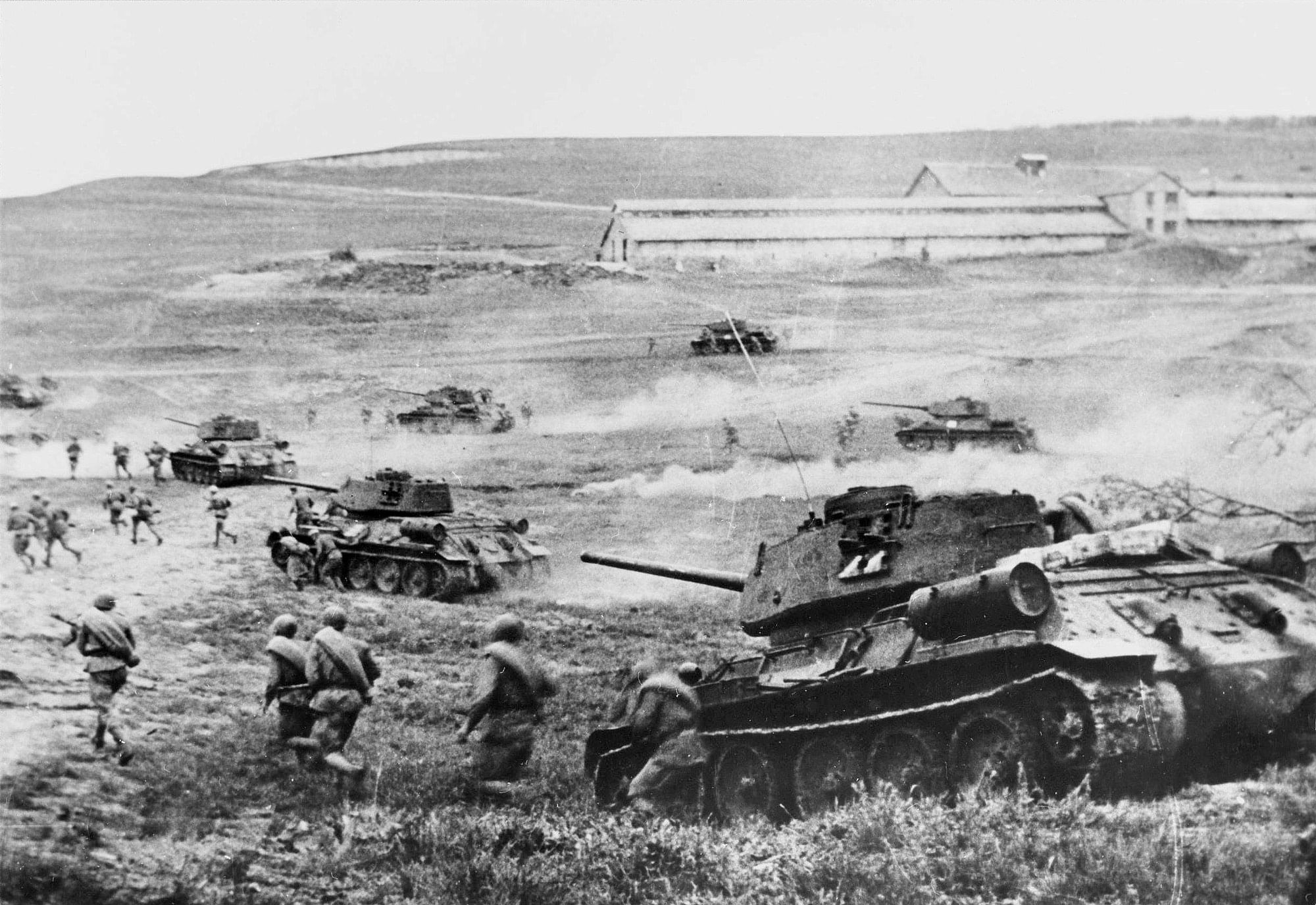
Kursk Battle Soviet Counter-Attack
After the start of the German offensive on July 5, the Headquarters of the Supreme High Command ordered almost all fronts to switch to active offensive operations. This was done in order to deprive the enemy of the opportunity to maneuver his reserves and transfer troops to the Kursk direction from other sectors of the front. The troops of the Southwestern and Southern fronts played a particularly important role.
Lieutenant General V.I. Chuikov, who participated after the Battle of Stalingrad at the head of the 8th Guards. And in the July offensive of the South-Western Front, noted:
The Southwestern Front was to launch an offensive on Barvenkovo; Southern front – from the Matveev Kurgan area to the west, to Stalino and further to Melitopol; Bryansk Front – to Orel; Western front – to Karachev. In such an environment, the German command was deprived of any opportunity to maneuver reserves.
General Raus, also mentioning that the offensive of the 9th Army bogged down, indicated another reason: “Ultimately, it was the offensive of the Red Army along the Mius River and at Izyum that did not allow the 4th Panzer Army to continue the offensive to the Psel line, Foam. The 24th Panzer Corps was brought into action on the southern wing, and Army Group South no longer had strategic reserves. The initiative now belonged to the Russians. The attack on Kursk was canceled… “.
Izyum-Barvenkovskaya offensive operation
The Izyum-Barvenkovskaya offensive operation was carried out from July 17 to July 27, 1943 by the troops of the Southwestern Front in order to pin down the enemy’s Donbass grouping and prevent the transfer of his troops to the Battle of Kursk area. The task of mobile formations is to enter the gap and strike in the direction of Stalino, in cooperation with the troops of the Law Firm, to surround the Donbass group of Germans. The enemy pulled up his operational reserves – 17 TD and 23 TD, as well as SS Viking TD, nevertheless, Soviet troops crossed the Seversky Donets, captured and expanded bridgeheads on its right bank, fettered the German reserves, thereby providing significant assistance to the troops of the VF in defense near Kursk.
Miusskaya offensive operation
Miusskaya offensive operation was carried out from July 17 to August 2, 1943 by the troops of the Law Firm. The front was faced with the task of successively defeating the opposing forces of 6A and diverting the enemy’s reserves from the Kyp direction. The German command sent to the breakthrough area, in addition to the 16th motorized division (md), part of the 23rd division, which was returned from halfway to Kharkov, as well as 336th infantry division and some units; significant aviation forces were urgently transferred from the Belgorod-Kharkov direction to the Donbass. On July 29, the 2nd SS Panzer Corps was redeployed from Kharkov to the bridgehead area on the right bank of the Mius as part of tank divisions: “Dead Head”, “Reich”, as well as 3 TD. In the current situation, the troops of the Law Firm were unable to break through the heavily fortified defenses of the enemy and break into the center of Donbass; an order was received to withdraw to the left bank of the Mius.
The defeat of the Oryol and Belgorod-Kharkov groups of Germans
Offensive operations near Orel and Kharkov unfolded on a front that exceeded 600 km; troops of five fronts participated in them. The depth of operations by the time the tasks were completed reached 180 km.
“The counteroffensive of the Red Army near Kursk had its own characteristics that distinguished it from the counteroffensive near Moscow and on the Volga. The armed struggle here assumed an even broader scope. Suffice it to say that all 5 tank armies that the Red Army had at that time, and 22 combined arms armies, took part in the counteroffensive. If two fronts attacked near Moscow in 1941, and three on the Volga in the winter of 1942/43, then near Kursk the counteroffensive was carried out by the forces of five fronts.
Oryol strategic offensive operation “Kutuzov”
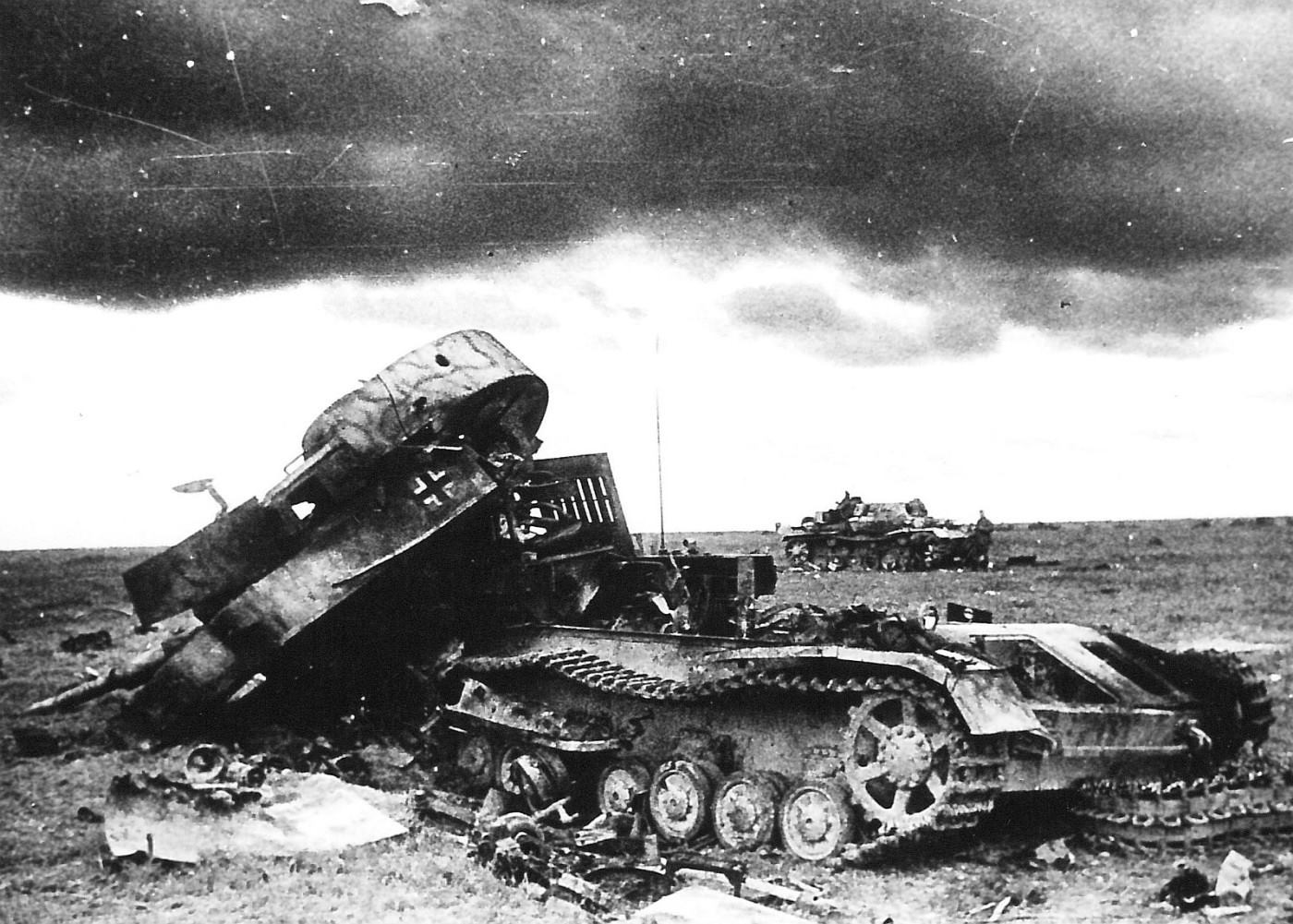
Destroyed Panzer 4
Even when organizing and planning the defense of the Kursk salient in March 1943, the Headquarters of the Supreme High Command provided for the transition of the troops of the left wing of the Western, Bryansk and Central (after the liquidation of the results of the German offensive) fronts to the offensive. On July 12, the Western (commanded by Colonel General Vasily Sokolovsky) and Bryansk (commanded by Colonel General Markian Popov) fronts launched a strategic offensive (according to a pre-developed plan, codenamed “Kutuzov”) against the 2nd Panzer and 9th armies of the Germans in area of the city of Orla. The plan also provided for the participation of the troops of the Central Fleet (right flank) in the offensive from the Ponyri, Arkhangelsk region. By the end of the day on July 13, Soviet troops broke through the enemy defenses. On July 26, the Germans were forced to leave the Orlovsky bridgehead and began to retreat to the Hagen defensive line (east of Bryansk). On August 5, at 05-45, Soviet troops completely liberated Oryol.
According to Eremenko A.I., the news of the capture of Orel and Belgorod came during a trip to the front of Stalin I.V., when the plan for the Smolensk operation was being discussed (the village of Khoroshevo, July 5, 1943)
“Stalin said that in honor of the troops who took these cities, it is worth making a salute in Moscow and always do this in connection with the liberation of large cities and strategically important points… I.V. Stalin immediately called Moscow and gave the order to prepare a salute from 124 guns for his return to Moscow, that is, by tonight.
On August 5, the first salute in the entire war was given in Moscow – in honor of the liberation of Orel and Belgorod. According to Soviet data, the losses of the Wehrmacht in the Oryol operation amounted to about 90 thousand people. Zhukov G.K. noted an important feature:
“On August 5, the troops of the Bryansk Front liberated Orel… When we, A.I. Antonov and A.M. Vasilevsky reported to the Supreme Commander about the possibility of encircling enemy groups in the Orel region, for which it was necessary to significantly strengthen the left wing of the Western Front, and. V. Stalin said:
“Our task is to expel the Germans from our territory as soon as possible, and we will surround them when they become weaker…
We did not insist on our proposal, but in vain. I should have been more assertive about my point of view. Our troops were then already able to carry out encirclement and destruction operations.
Belgorod-Kharkov strategic offensive operation “Rumyantsev”
On the southern face, the strategic offensive (according to the developed plan under the code name “Commander Rumyantsev”) by the forces of the Voronezh and Steppe fronts began on August 3.
As part of the Belgorod-Kharkov Strategic Offensive Operation, the Belgorod-Bogodukhov and Belgorod-Kharkov front-line offensive operations were carried out.
During the Belgorod-Bogodukhov operation, on August 5, at about 18-00, Belgorod was liberated, on August 7 – Bogodukhov.
Developing the offensive in the Belgorod-Kharkov operation, on August 11, Soviet troops cut the Kharkov – Poltava railroad, and on August 23 captured Kharkov. The German counterattacks were not successful.
The development of the strategic offensive of the Red Army
Mginskaya offensive operation
Since the main forces of the Red Army were concentrating in the area of the Kursk salient, the Headquarters temporarily suspended offensive operations in the northwestern direction. Only in July, during the Battle of Kursk, did they decide to carry out the Mginsk offensive operation (July 22 – August 22, 1943). The fighting was fierce, and “in the Porechye region, the 18th German Army had no reserves left.” K. A. Meretskov notes that:
A little more, and the breakthrough site could be expanded. But reports began to come in from unit commanders that suddenly the resistance of the Nazis had increased dramatically. It turned out that the Nazi command completely removed two divisions from near Leningrad, intended to storm the city, and plugged the hole with them in order to localize the breakthrough, preventing it from turning into a wide gap.
As a result, the Germans used all the reserves to hold their positions, and could not transfer part of the forces of the Sever GA near Kursk.
Smolensk strategic offensive operation
By the beginning of August 1943, the general situation on the Soviet-German front, including the western strategic direction, was determined by the victories won by the Soviet Army near Kursk. It was important for the Soviet command to defeat as many enemy forces as possible by active actions in other directions in order not to allow him to use these forces to counter the counteroffensive of the Red Army. First of all, the western direction was referred to such sectors of the front as directly adjoining the area of the Kursk salient. The headquarters of the Supreme High Command prepared a major offensive operation, which received the code name “Suvorov” and began on August 7 with the offensive of the troops of the Western and left wing of the Kalinin fronts.
- N. Voronov, commander of the artillery of the Red Army, noted that: “above the command of the Kalinin and Western fronts, as well as over me, a representative of the Stavka, the threat of “taking my head off my shoulders” constantly hung with the sword of Damocles, if at least one enemy division from here it will be transferred to the south, where the main tasks were solved. The commander of the Kalinin Front, Eremenko A.I., adds:
“It is very significant that in the most difficult days of the catastrophe on the Kursk Bulge, the Hitlerite headquarters did not dare to take a single division from Army Group Center, but, on the contrary, in the first half of August transferred 13 divisions from under Orel to the Smolensk direction.”
Donbass strategic offensive operation
The close interaction of the fronts and prompt response to the situation became a hallmark of the summer-autumn offensive of 1943. Soviet troops created tension in one of the directions and forced the German command to draw up reserves there, transferring them from other fronts. On the weakened sector, our army immediately delivered an attack blow. On August 13, 1943, the Donbass operation began with the offensive of the right wing of the Southwestern Front; On August 16, having broken through the German defenses, the troops of the Southern Front went on the offensive.
Offensive from the top of the Kursk salient
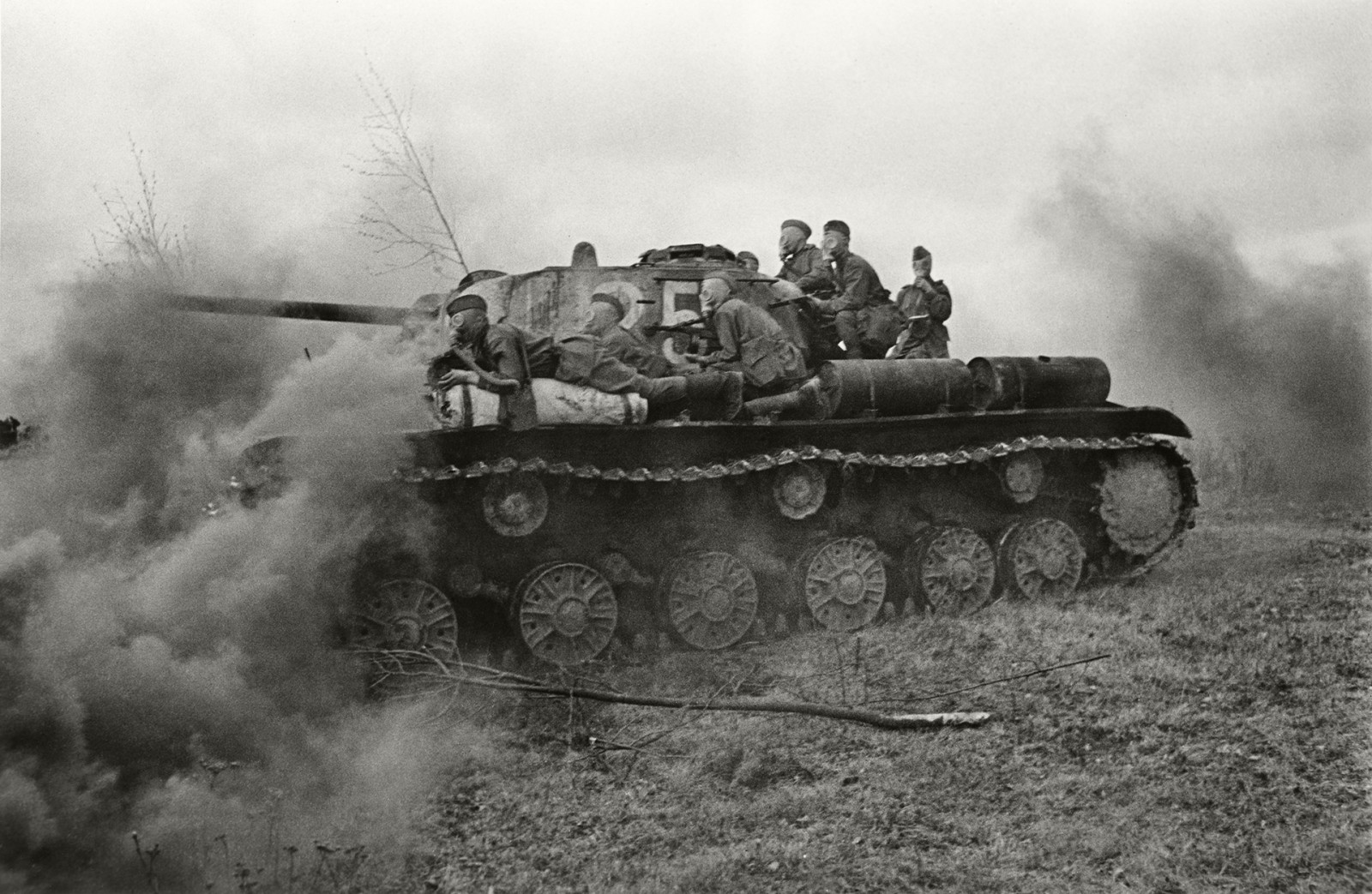
Advancing Soviet KV1 Tank With Mounted Infantry
The successful development of hostilities on the northern and southern faces of the Kursk strategic bridgehead created favorable conditions for striking from its top at the junction of the German Army Groups “South” and “Center”. It was supposed to use this opportunity even when planning the summer campaign of 1943: “The attack on Kharkov, Poltava, Kiev was, in the opinion of the General Staff, the most promising”. S. M. Shtemenko notes that the idea of defeating the enemy’s southern grouping did not affect the main, western strategic direction; GA “Center” would threaten the flanks of the advancing fronts.
Kiev direction
In an atmosphere of secrecy, the Headquarters of the Supreme High Command, even during the offensive operations of the Battle of Kursk, issued directive No. 30168 dated 16.8.43 on the offensive of the Central Front in the general direction of Konotop, Nezhin, Kyiv. Already on August 20, 1943, the command of the Central Front reported to the General Staff the plan of the Chernigov-Pripyat operation, which was approved on August 22. According to the memoirs of the correspondent of the Krasnaya Zvezda, Troyanovsky P.I., on the morning of August 25 he was sent to 65A, General P.I. Batov; The commander, during a conversation on the evening of August 27, reported:
“I advise you to immediately follow Ivan Danilovich Chernyakhovsky, to the sixtieth army. An hour ago, the commander of the front called me. Parts of our neighbor rushed forward almost twenty kilometers in a day and are now approaching Glukhov and Rylsk. And this is already Ukraine, comrades, the Kiev direction… Konev’s armies have already taken Kharkov and continue the offensive. The armies of our front will rush to Kyiv… “
So for the first time we heard the long-awaited words – “Kiev direction”… By the way, officially, nationwide, so to speak, to the whole world, the words “Kiev direction” were first heard in the order of the Supreme Commander-in-Chief of September 9th.
However, as near Kharkov, the enemy put up serious resistance – part of the Wehrmacht still had hope to change the course of the war and return the lost territories. As an example, Troyanovsky P.I. cites the words from a letter to Germany from a corporal from the 184th infantry regiment, “found from him, who was killed right there, near the village of Sopych”:
“There is nothing so pitiful as it is a pity to leave Ukraine. We had a great life here. Chickens, geese, sugar, milk, lard – there was plenty of everything. And how many Eastern workers we have mobilized from here! The Fuhrer promised to give us war veterans land allotments in Ukraine. The earth and climate are amazing. Thirty-fifty local hectares plus cheap peasant power would provide our whole family with a joyful life… It’s a pity, it’s a pity to leave here. However, they say that we will return, and I believe this… “
In the words of the same Troyanovsky, the troops of Rokossovsky and other fronts “endowed land allotments (posthumously)” to tens of thousands of German soldiers. German total losses were around 321,000 by the end of the operation on 30 September. The operation ended with the almost complete liberation of Left-Bank Ukraine from German troops and the capture of bridgeheads on the right bank of the Dnieper. The radical turning point in the war that occurred during the Battle of Kursk was finally completed. By the morning of November 6, the capital of Soviet Ukraine, Kiev, was liberated.
Sicilian strategic operation
Germany and allies
Military campaign of Italian troops in the USSR 1941-1943. ended with the defeat of the 8th Army at the end of February 1943, and Mussolini withdrew its remnants from the Eastern Front.
- Churchill noted that on May 20 a meeting was held with Hitler, where Keitel, Rommel, Neurath and others were present. Neurath, in particular, said:
The German troops in Sicily have no doubt become rather unpopular… Firstly, we have eaten all the food they had, and now the English will come because of us, although… the Sicilian peasants, in fact, do not mind this. They believe that this will put an end to their suffering… Whenever I… complained that German soldiers were being abused in the streets, I was told that…: “… You yourself have made yourself unpopular. You made requisitions and ate all our chickens.”
– Churchill W. World War II. – M.: Military Publishing, 1991
The Germans became “unpopular” not at all because of the “eaten chickens”, but because of the loss of a number of campaigns, including near Stalingrad. Where about 130 thousand Italians were surrounded during the offensive of the Soviet troops and, according to Italian sources, about 21 thousand soldiers died in battle, 64 thousand were captured and 45 thousand managed to retreat. But an unenviable fate awaited the survivors: another defeat of the German troops, now in the Battle of Kursk, and the landing of the allies that followed during its landing led to Italy’s exit from the war. After that, the Germans disarmed the Italian units that refused to go into the service of Germany and send them to prisoner of war camps; there were also executions of Italian soldiers and officers. This is how Germany paid its recent ally, subsequently, at the Nuremberg trials, a list of Italian officers shot in Lvov was presented.
Anti-Hitler coalition
The decision to land the troops of the anti-Hitler coalition in Sicily was made by the leaders of the allied countries in early 1943:
At the Casablanca conference, held in January, the decision was made to invade Sicily after the capture of Tunisia… Political factors play their part, and the capture of Sicily and the direct invasion of Italy should have led to much more rapid and far-reaching results. The capture of Sicily was an operation of paramount importance. Although it was overshadowed by subsequent events in Normandy, its significance should not be underestimated…
– Churchill W. World War II. – M.: Military Publishing, 1991
But the landing of the allies was expected, to counteract it, groups of troops were created in Greece (in particular, 1 TD left there), in Sicily and southern France. If the Italian coastal defense divisions offered little resistance to the enemy, then their mobile divisions showed themselves quite well. Kesselring, although he reported the impossibility of throwing the enemy into the sea, intended to continue to hold Sicily. There was no immediate threat in the Mediterranean Theater on July 13, including what could have caused the Citadel to be aborted if it had any prospects of success.
On the impact of the landing in Sicily on the continuation of Operation Citadel
Often, Manstein’s memoirs are cited as the reason for the failure of the offensive according to the Citadel plan, according to which, after the Allied landing in Sicily (July 9-10) and the start of Operation Kutuzov (July 12). July 13 Hitler called to his headquartersField Marshals Manstein and Kluge and raised the question of ending Operation Citadel. Manstein objected, pointing out that it was necessary first to defeat the Soviet troops on the Kursk ledge, otherwise a threatening situation would arise not only in the Donbass, but also near Kursk. Since the 9th Army could not advance further, and Kluge insisted on retreating to their previous positions, Manstein proposed to advance from the south to Kursk, and then turn west, force the Soviet troops in the Kursk salient to fight with an inverted front, and defeat them. At the same time, Kempf’s group was to strike in an easterly direction, as well as by simultaneous actions together with the 4th Army to destroy the enemy at the junction of two formations. Hitler gave his consent
But, as L. N. Lopukhovsky notes, “the transcript of the meeting on July 13 has not yet been found,” nevertheless, “there is a link to the transcript of the meeting in the military operations log of the OKW”:
The Fuhrer declared that “the cowardice of the Italians opens the way for the enemy to the fortress of Europe from the south,” after which he expressed his intention to suspend Operation Citadel until the situation in Italy was clarified (emphasis mine. – L. L.). Field Marshal von Kluge fully agreed with this, while Manstein continued to insist on continuing the attack on Kursk from the south. In the end, the Fuhrer decided to give him a chance…
– quoted from: Kriegstagebuch des Oberkommando der Wehrmacht (Wehrmachtfuhrungsstab). bd. III. Frankfurt a/M., 1963, S. 777.
And he clarifies that “that the phrase “expressed the intention to suspend the operation” does not at all mean a decision to stop the operation, and even immediately.”
Manstein adds that “after Operation Citadel was also finally terminated by Hitler’s order on July 17 by the Yug group, the command of the group decided to temporarily remove large tank forces from this flank in order to restore the situation in the Donbass with the help of these units.” On the same day – July 17, the offensive of the Southwestern and Southern fronts began on the middle Donets and Mius.
For the transfer to Italy, 2 SS TCs were scheduled, but then they stopped only at the Leibstandarte division. R. Ponomarenko notes that “at first, the Leibstandarte was heading for the Mius along with everyone else, but at 23:55 on July 25, the division received an order to ‘stop moving and prepare to be sent in an unknown direction’.”
- N. Lopukhovsky gives a later date:
The question of the need to transfer forces to Italy from the Eastern Front arose only after a political crisis broke out in Rome… On July 25, the Duce was arrested. And Hitler decided that now he needed politically reliable units in Italy. On July 26, he ordered the 3rd TGD to move to the Rome region and transfer the 2nd SS Panzer Corps to Italy as soon as its divisions “can free themselves.” But the SS corps, despite Hitler’s decision, was left on the Eastern Front to eliminate numerous crises in the GA “South” zone. Only TD “AG” was sent to Italy without tanks and other heavy weapons.
And concludes:
Thus, the actions of the allies in Sicily could not be the direct reason for the termination of the operation “Citadel”. Without a doubt, this operation would not have been interrupted if it had had prospects of success. At the same time, the impossibility of continuing the offensive by Army Group Kluge is Hitler in the first place in the list of reasons that forced him to ultimately stop the operation… But it was not the landing of the allies on the island of Sicily that stopped the German offensive near Kursk. He was stopped by Soviet soldiers and commanders.
In Western historiography, a different interpretation of the relationship between the landing in Sicily and the termination of Operation Citadel has become quite widespread. In particular, R. Atkinson (Rick Atkinson), author of a trilogy on the US contribution to the liberation of Europe from Nazism, believes that Hitler “stopped a major offensive near Kursk just a week after it began, which was partly due to the need to transfer forces to Italy” (canceled a major offensive at Kursk after only a week, in part to divert forces to Italy), which caused the weakening of the Wehrmacht on the Eastern Front..
According to other authors, the hostilities in Italy made it necessary to replace Italian soldiers with German ones, both in Italy itself and, to a lesser extent, in the Balkans., as a result of which a fifth of the Wehrmacht ended up in Southern Europe (instead of the Eastern Front), and this ratio remained almost until the very end of the war. Thus, the landing in Sicily did not so much draw the Wehrmacht forces off the Eastern Front as it deprived it of the strategic reserves that were being trained in France, necessary to continue the offensive.
Results of the Battle of Kursk
Completion of a radical change in the course of the war
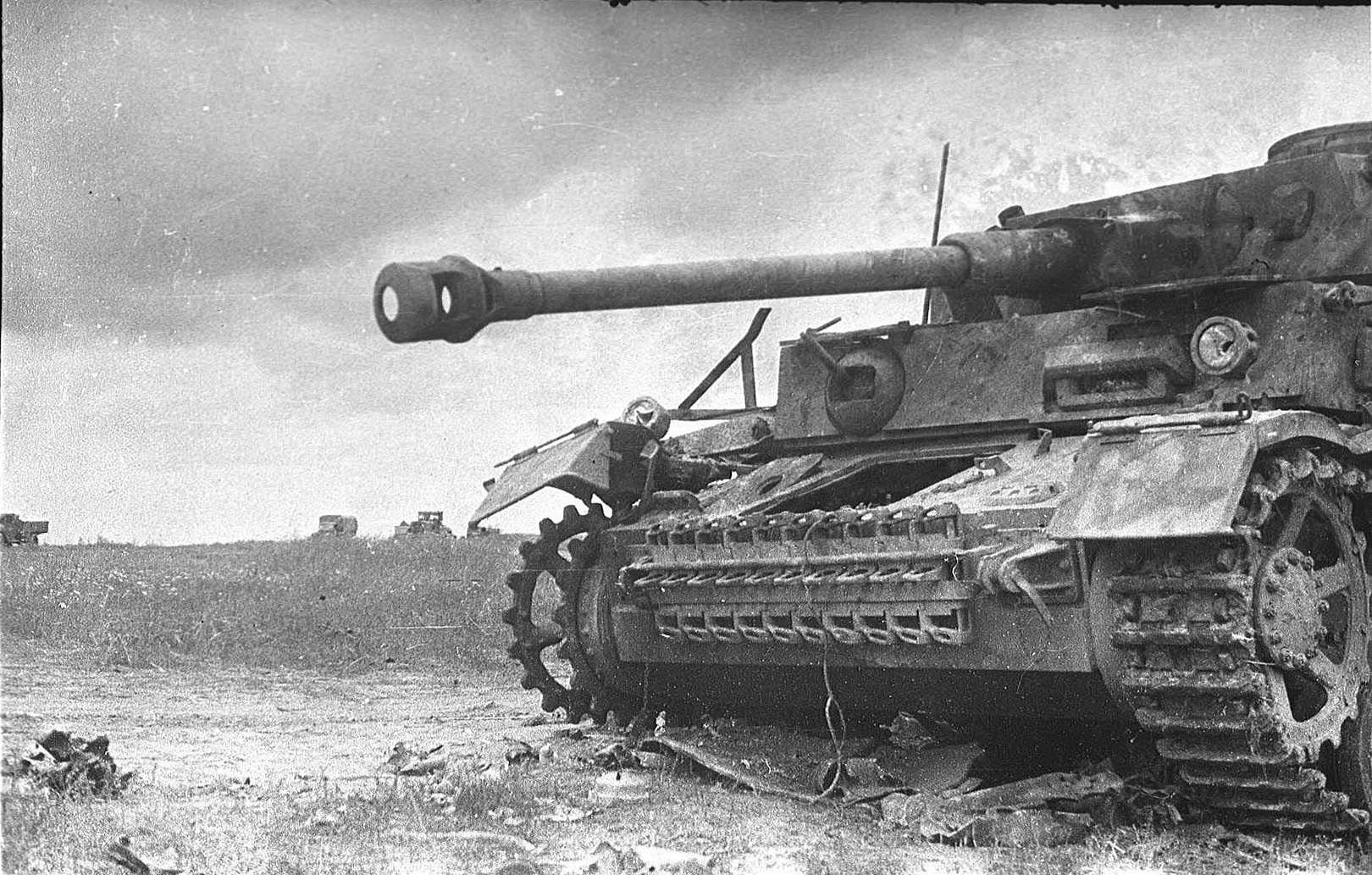
Destroyed Panzer4
The victory in the Battle of Stalingrad determined the transition of the Red Army from defense to a strategic offensive. In the winter-spring of 1943, the Red Army developed success by breaking through the blockade of Leningrad, launching an offensive in the North Caucasus and in the upper reaches of the Don. However, the Germans managed to carry out a successful counterattack and recapture Kharkov in March 1943. After the Battle of Kursk, the strategic initiative firmly passed into the hands of the Soviet command. Left-bank Ukraine and the city of Kiev were liberated. This period of the war is called the turning point.
The victory at the Kursk Bulge and the subsequent strategic offensive according to the plan of the summer-autumn campaign of 1943 marked the completion of a radical turning point in the course of the Great Patriotic War and, as a result, in World War II.
After the end of the battle on the Kursk Bulge, the German command lost the opportunity to conduct strategic offensive operations. Local massive offensives, such as the “Watch on the Rhine” (1944) or the operation at Balaton (1945), were also not successful.
Zhukov G.K. noted:
“Irritated by failures and extremely heavy losses, Hitler, as he always did in such cases, shifted all the blame for the failure of the Citadel offensive operation onto the heads of his field marshals and generals. He removed them from their positions, replacing, in his opinion, more capable ones. Hitler did not understand that the failure of a major strategic operation depends not only on the commanders, but is determined mainly by a large sum of military-strategic, political, moral and material factors.
The opinion of the allies of the USSR in the anti-Hitler coalition
The US Chiefs of Staff Committee in August 1943 prepared an analytical document in which he assessed the role of the USSR in the war. “Russia occupies a dominant position in the Second World War,” the report noted, “and is a decisive factor in the forthcoming defeat of the Axis countries in Europe. While in Sicily the troops of Great Britain and the United States are confronted by two German divisions, the Russian front pins down about 200 German divisions. When the Allies open a second front on the continent, it will certainly be secondary to the Russian front, the Russian will continue to play a decisive role. Further, it was concluded that
“The main military operations will be conducted in Russia. Without Russia’s participation in the war in Europe, it is impossible to defeat the Axis countries, and the position of the United Nations will be dangerous.
President Roosevelt was aware of the danger of further delaying the second front. He told his son on the eve of the Tehran conference:
“If things in Russia continue as they are now, then it is possible that next spring there will be no need for a second front!”
— Roosevelt E. Through his eyes. – M., 1947. – S. 161.
Confessions of German Generals
Field Marshal Erich von Manstein, who developed and carried out Operation Citadel, subsequently wrote:
It was the last attempt to keep our initiative in the East. With her failure, tantamount to failure, the initiative finally passed to the Soviet side. Therefore, Operation Citadel is a decisive turning point in the war on the Eastern Front.
– Manstein E. Lost victories / Per. with him. – M., 1957. – S. 423.
According to Guderian,
As a result of the failure of the Citadel Offensive, we suffered a decisive defeat. The armored forces, replenished with such great difficulty, were put out of action for a long time due to heavy losses in people and equipment. Their timely restoration for conducting defensive operations on the Eastern Front, as well as for organizing defense in the west in the event of a landing that the Allies threatened to land next spring, was called into question. Needless to say, the Russians were quick to exploit their success. And there were no more quiet days on the Eastern Front. The initiative completely passed to the enemy.
– Guderian G. Memoirs of a soldier. – Smolensk: Rusich, 1999
Estimate of Albert Speer, Reich Minister for Armaments and War Production:
The offensive began on July 5, but, despite the widespread use of the latest military equipment, we did not manage to cut off the Kursk salient and encircle the Soviet troops. Excessive self-confidence once again failed Hitler, and after two weeks of fierce fighting, he was forced to admit the futility of his hopes. The unsuccessful outcome of the Battle of Kursk meant that from now on the Soviet Union seized the strategic initiative even at a favorable time of the year for us.
– Speer A. Memoirs / [Trans. with him. S. Friedland; I. Rozanova]. — 2nd ed., corrected. — M.: Zakharov, 2010. — 688 p.
.
Disruption of further plans of the German command
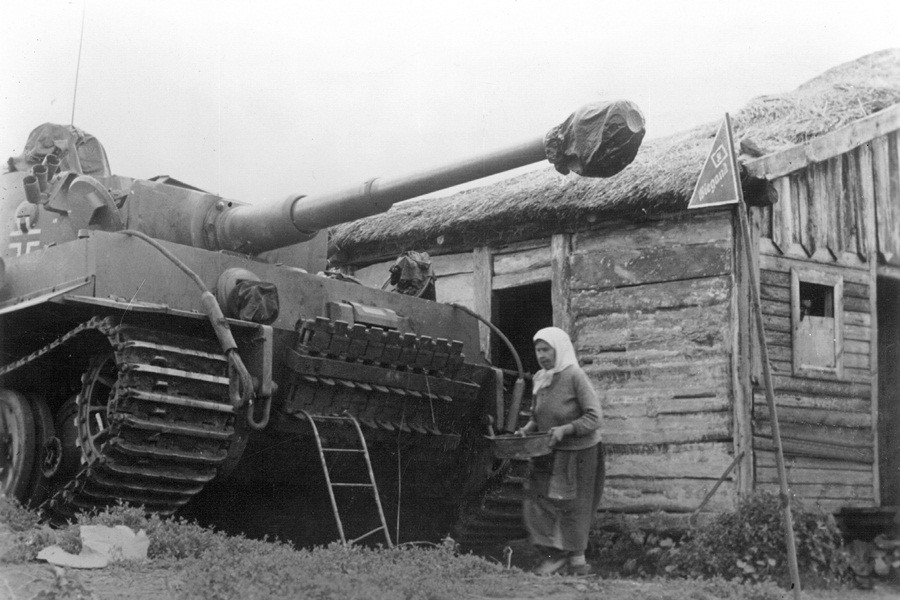
Kursk Battle- Soviet Civilians With German Tank
Operation Citadel was the first of the Wehrmacht operations planned for the summer and autumn of 1943, which made it possible to reach the deep rear of the Soviet troops and create a threat to Moscow. On March 22, Hitler gave the order to conduct Operation Hawk, but the prospects that opened up, if successful, in two days forced them to instruct GA South to develop a larger operation, code-named Panther.
The success of operations “Citadel” and “Panther” was supposed to be the signal for the start of the German offensive on Leningrad. The operation was originally codenamed “Berenfang” (“Bear Hunt”). The first stage was called “Parkplatz-I”, the second – “Parkplatz-II”. The American historian M. Caidin notes about the planned occupation of Sweden:
“A lot more was at stake than just the city of Kursk or the advance across the terrain to the north, south and east, namely, what would never be reflected in the diagrams and maps – the merciless massacre of the Russians, and this was the essence of the German plan: to wear down, grind, disperse, kill and capture… Later, if Operation Citadel goes as Hitler expected, a big new attack on Moscow will follow. Later, he will put into practice his top secret plan “Arctic Fox”, and the German armed forces will occupy Sweden with a lightning strike. Later, he… will strengthen the troops in Italy to repel the Allied invasion and throw them into the sea, for he knew that the time for this invasion was approaching. He will send powerful reinforcements to the Atlantic Wall – perhaps sufficient ones,
– Quoted from: Caidin. M. The Tigers Are Burning. New York: Hawthorn, 1974, p. 4, 5, 8.
The victory of the Red Army near Kursk and the troops of the anti-Hitler coalition in Sicily made the plans of the German command unrealizable.
International Significance of the Victory in the Battle of Kursk
As a result of the defeat of significant Wehrmacht forces on the Soviet-German front, more favorable conditions were created for the deployment of American-British troops in Italy, the beginning of the disintegration of the fascist bloc was laid – the Mussolini regime collapsed, and Italy withdrew from the war on the side of Germany. Under the influence of the victories of the Red Army, the scale of the resistance movement in the countries occupied by German troops increased, and the authority of the USSR as the leading force of the anti-Hitler coalition was strengthened.
In the Battle of Kursk, Soviet soldiers showed courage, steadfastness and mass heroism. According to the IVI VA of the General Staff of the Armed Forces of the Russian Federation:
Over 100 thousand people were awarded orders and medals, 231 people were awarded the title of Hero of the Soviet Union, 132 formations and units received the title of guards, 26 were awarded the honorary titles of Oryol, Belgorod, Kharkov and Karachev.
Summing up the results of the summer-autumn campaign in a report on November 6, 1943, Supreme Commander-in-Chief I.V. Stalin noted:
“… the results and consequences of the victories of the Red Army went far beyond the boundaries of the Soviet-German front, changed the entire further course of the world war and acquired major international significance. The victory of the Allied countries over the common enemy approached, and the relations between the allies, the military commonwealth of their armies, contrary to the expectations of the enemies, not only did not weaken, but, on the contrary, strengthened and strengthened… the allies subjected and continue to subject important industrial centers of Germany to a thorough bombardment and thereby significantly weaken the military power of the enemy… regularly supply us with various weapons and raw materials… it can be said without exaggeration that with all this they greatly facilitated the success of our summer campaign ”
Geopolitical success of the summer-autumn campaign of 1943
The victory in the Battle of Kursk made it possible to launch a broad offensive according to the plan of the summer-autumn campaign, while liberating a significant territory.
G.K. Zhukov notes:
The battle in the area of Kursk, Orel and Belgorod is one of the greatest battles of the Great Patriotic War and World War II in general. Here, not only were the select and most powerful groups of Germans defeated, but faith in the Nazi fascist leadership and in Germany’s ability to resist the ever-increasing power of the Soviet Union was irretrievably undermined in the German army and people.
“Germany will be defeated by the autumn of 1944”
The efforts of the anti-Hitler coalition intensified, the materials of the first Quebec conference reflect the desire to end the war in Europe by the fall of 1944:
…42. Consideration of upcoming operations. We have ordered… to conduct a study of the following issues:
- b) study (assuming that Germany will be defeated by the autumn of 1944) the potential… to expand the transport of goods to China… to use all the aviation that will be available in Southeast Asia and in China in 1944-1945.
– Report of the Joint Anglo-American Headquarters on the results of the Quadrant Conference
It is supposed to achieve success in the main theaters of war:
… 2. Together with Russia and other allies, achieve the unconditional surrender of the Axis countries as soon as possible.
…5. After the defeat of the Axis countries in Europe, in cooperation with other countries of the Pacific basin and, if possible, with Russia, direct all the resources of the United States and Great Britain to achieve in the shortest possible time the unconditional surrender of Japan.
The Question of Partitioning Germany
Subsequently, the question of the future of Germany was discussed at the Tehran Conference.
At the Fourth Meeting of the Conference of the Heads of Government of the USSR, the USA and Great Britain it was noted:
Stalin. What other questions are there for discussion?
Roosevelt. Question about Germany.
Stalin. What suggestions are there for this?
Roosevelt. The dismemberment of Germany. [c.93]
Churchill. I am for the dismemberment of Germany. But I would like to consider the question of the partition of Prussia. I am for the separation of Bavaria and other provinces from Germany.
Roosevelt. In order to stimulate our discussion on this question, I would like to present the plan I myself drew up two months ago for the partition of Germany into five states.
Thus, by the end of September, F. Roosevelt already had a “plan for the dismemberment of Germany”, in fact, a month after the end of the Battle of Kursk. I. V. Stalin noted:
If the battle of Stalingrad foreshadowed the decline of the Nazi army, then the battle of Kursk put it in front of a catastrophe.
Losses
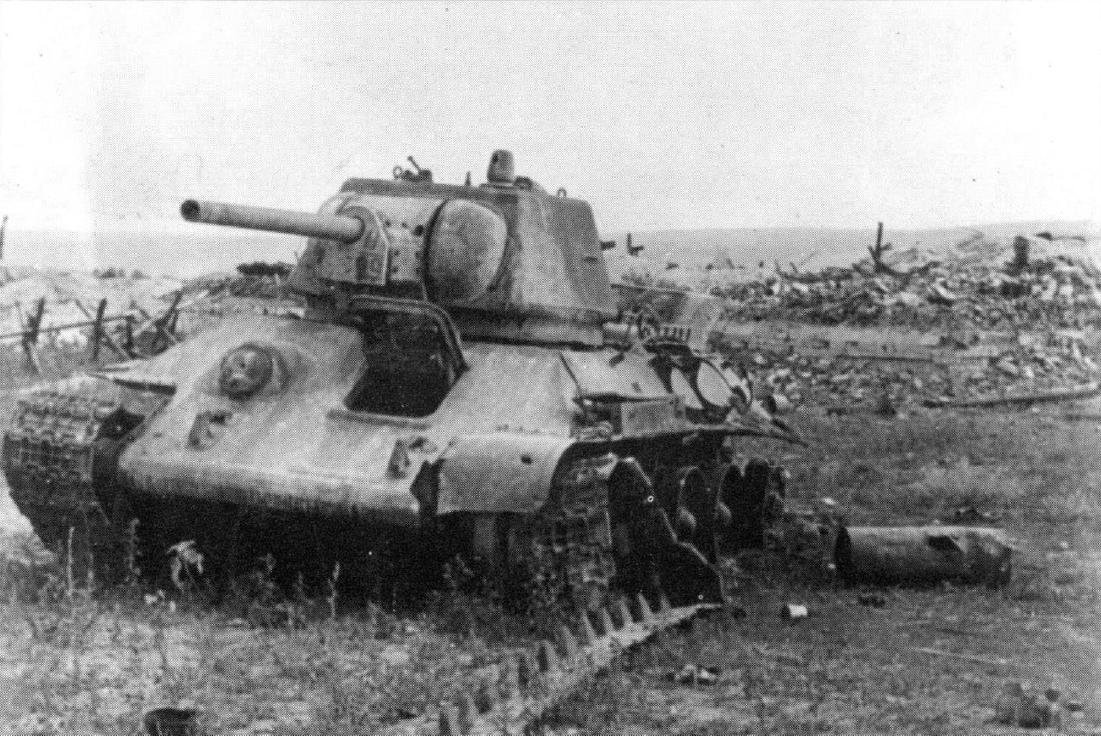
Destroyed T-34
The losses of the parties in the battle remain unclear. Thus, Soviet historians, including academician A. M. Samsonov, speak of more than 500 thousand killed, wounded and captured, 1500 tanks and over 3700 aircraft in 50 days of the battle. The authors of the 12-volume work “The Great Patriotic War of 1941-1945” cite:
Soviet troops lost more than 863 thousand people, including more than 254 thousand irretrievably, over 6 thousand tanks and self-propelled guns, almost 5300 guns and mortars, 1626 combat aircraft
– WWII volume 3, chapter “Arc of Fire”, p. 574
According to the report of the headquarters of the engineering troops of the Voronezh Front, 653 enemy tanks were blown up in our minefields in the period from 07/05/1943 to 07/20/1943
and source Describes the period from 07/21/1943 to 07/21/1943. Information. Document number: 2444, Document creation date: 07/21/1943 Archive: TsAMO, Collection: 203, Inventory: 2843, File: 430, Sheet of the beginning of the document in the file: 13 Authors of the document: VorF, Lieutenant Colonel Berlin, Major Vishnyakov Describes the military operation: Defensive period of the Battle of Kursk. 5.7-23.7.43
Losses according to G. F. Krivosheev
According to the research team led by the candidate of military sciences, Colonel-General G. F. Krivosheev, the total losses in the Battle of Kursk amounted to:
| Name of operations, terms of their implementation, duration | Combat composition and number of troops at the beginning of the operation | Loss of life in operation | ||||
| number of connections | number | irrevocable | sanitary | Total | average daily | |
| Kursk defensive operation, 5.07.-23.07.1943 | Divisions – 77, corps – 9, brigades -14, UR-3 | 1272700 | 70330 (5.5%) | 107517 | 177847 | 9360 |
| Operation “Kutuzov”, 12.07.-18.08.1943 | Divisions – 82, corps – 8, brigades -14, UR-3 | 1287600 | 112529 (8.7%) | 317361 | 429890 | 11313 |
| Operation “Rumyantsev”, 3.08.-23.08.1943 | Divisions – 50, corps – 11, brigades – 5 | 1144000 | 71611 (6.20%) | 183955 | 255566 | 12170 |
| Battle of Kursk, 5.07.-23.08.1943, 50 days | Divisions – 132, corps – 19, brigades – 19, UR-3 | 2431600 | 254470 | 608833 | 863303 | 32843 |
We also provide excerpts from Table No. 82 “Losses of military equipment and weapons by periods of war and strategic operations”:
| Name of operations, terms of their implementation, duration | Small arms (thousand pieces) | Tanks and self-propelled guns (pcs.) | Guns and mortars (pcs.) | Combat aircraft (pcs.) | ||||
| in operation | average daily | in operation | average daily | in operation | average daily | in operation | average daily | |
| Kursk defensive operation, 5.07.-23.07.1943, 19 days | 70.8 | 3.7 | 1614 | 85 | 3929 | 207 | 459 | 24 |
| Oryol offensive operation, July 12-August 18, 1943, 38 days | 60.5 | 1.6 | 2586 | 68 | 892 | 23 | 1014 | 27 |
| Belgorod-Kharkov offensive operation, 3.08.-23.08.1943, 21 days | 21.7 | one | 1864 | 89 | 423 | twenty | 153 | 7 |
| Battle of Kursk, 5.07.-23.08.1943, 50 days | 153 | 6064 | 5244 | 1626 | ||||
Losses according to the German ten days
In particular, based on 10-day reports of their own losses, the Germans lost:
| For the period 01–10.7.43 | killed | wounded | prisoners/prop. without a trace | total losses |
| 4TA | 1577 | 8214 | 186 | 9977 |
| Gr. Kempf | 1370 | 7697 | 561 | 9628 |
| 9A | 3511 | 15923 | 755 | 20189 |
| Total: | 6458 | 31834 | 1502 | 39794 |
| For the period 11–20.7.43 | killed | wounded | prisoners/prop. without a trace | total losses |
| 4TA | 1400 | 4081 | 244 | 5725 |
| Gr. Kempf | 1280 | 6707 | 154 | 8141 |
| 9A | 1523 | 6061 | 674 | 8258 |
| Total: | 4203 | 16849 | 1072 | 22124 |
| For the period 21–31.7.43 | killed | wounded | prisoners/prop. without a trace | total losses |
| 4TA | 910 | 6064 | 475 | 7449 |
| Gr. Kempf | 799 | 4128 | 343 | 5270 |
| 9A | 1612 | 6306 | 990 | 8908 |
| Total: | 3321 | 16498 | 1808 | 21627 |
Total total losses of enemy troops that took part in the offensive on the Kursk salient for the entire period 01-31.7.43.: 83545. When using the so-called. “ten-day reports” it is necessary to take into account that:
- For the Red Army, losses are taken from 07/05/1943 to 08/23/1943 – 49 days. For the Wehrmacht from 07/01/1943 to 07/31/1943 – 31 days. At the same time, from 01.07 to 05.07 there were no military operations, that is, for 25 days of active operations.
- For the Red Army, all losses, including non-combat losses in the reserve armies. For the Wehrmacht in three out of seven armies: losses in the 1st Panzer, 2nd Panzer, 6th and 2nd Armies, 4th and 6th Air Fleets are not taken into account, while partial data are not reported.
According to the German historian Rüdiger Overmans, during July and August 1943 the Germans lost 130,429 killed. However, according to Soviet data, from July 5 to September 5, 1943, about 420,000 Nazis were destroyed (which is 3.2 times higher than Overmans’ data) and about 38,600 people were taken prisoner.
The Russian historian Igor Shmelev cited the following data in 2001: in 50 days of fighting, the Wehrmacht lost about 1,500 tanks and assault guns; The Red Army lost over 6,000 tanks and self-propelled guns.
In addition, according to German documents, the Luftwaffe lost 1,696 aircraft on the entire Eastern Front in July-August 1943.
The work of the General Staff says:
During the offensive from July 12 to August 23, 35 divisions were defeated, including 22 infantry, 11 tank and 2 motorized. In addition, all the other 42 divisions suffered heavy losses and largely lost their combat capability.
In the Battle of Kursk, the German command used 20 tank and motorized divisions out of a total of 26 divisions that were available at that time on the Soviet-German front, and, as mentioned above, 13 were completely defeated.
To determine the losses of the Wehrmacht in the Battle of Kursk, the table given by Manstein in the book “Lost Victories” is of interest. In the original, the “Total” column and the “% of the original” column are absent – they were obtained by calculation, and there is a column “The number of enemy formations in front of the army front”, which is not given here due to the lack of combat capability, its fantastic nature and focus solely on justifying the subsequent retreat. These tables were presented as of August 20-21 and are given in the summary of the command of Army Group South. Losses in divisions are estimated, and not absolute losses in people, and losses in the 9th, 2nd tank armies, 6th air fleet operating on the northern face of the Kursk salient, 4th air fleet on the southern and 2nd th army in the west. However, it can be assumed that they were comparable in percentage terms (with the exception of the 2nd Army, where active operations were not conducted during the period under review). In Soviet historiography, August 23 is considered the end date of the Battle of Kursk, and the losses of the Red Army are given on this date.
| associations | front width | number of
divisions |
combat capability
(in divisions) |
% of the original
(not specified in the original) |
| 6th Army | 250 km | 10 infantry;
1 tank |
≈ 3 ¹/3
≈ ¹/2 |
33
50 |
| 1st Panzer Army | 250 km | 8 infantry;
3 tank; |
≈ 5 ¹/2
≈ 1 ¹/4 |
68
41 |
| 8th Army
(Gr. Kempf) |
250 km | 12 infantry;
5 tank; |
≈ 5 ³/4
≈ 2 ¹/3 |
48
46 |
| 4th Panzer Army | 270 km | 8 infantry;
5 tank; |
≈ 3 ¹/3
≈ 2 ¹/3 |
42
46 |
| Army Group South as a whole | 980 km | 38 infantry;
14 tank; |
≈ 18
≈ 6 ¹/2 |
47
46 |
| Total | 980 km | 52 | ≈24.5 | 47 |


